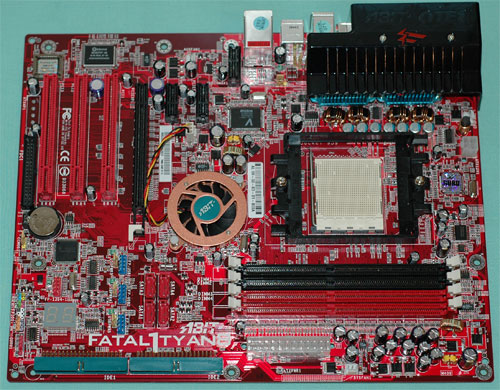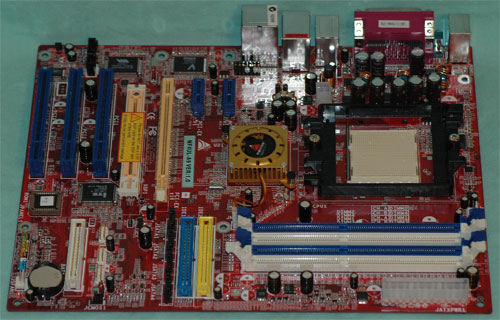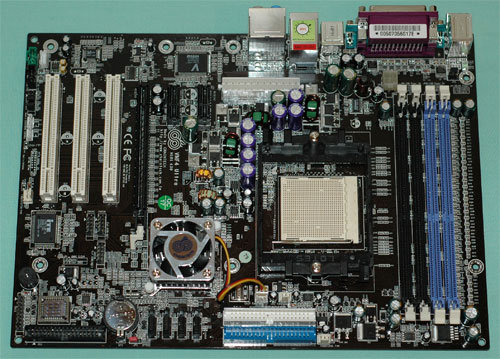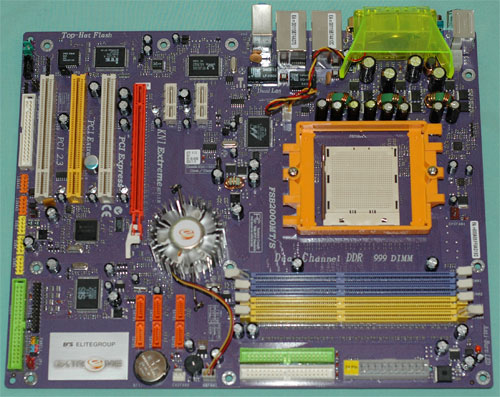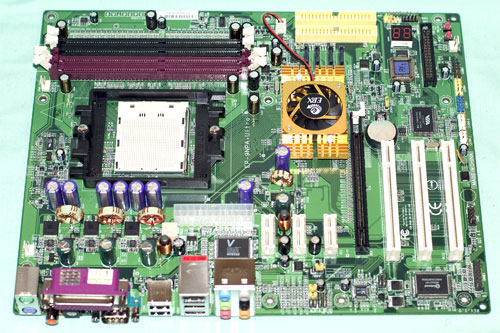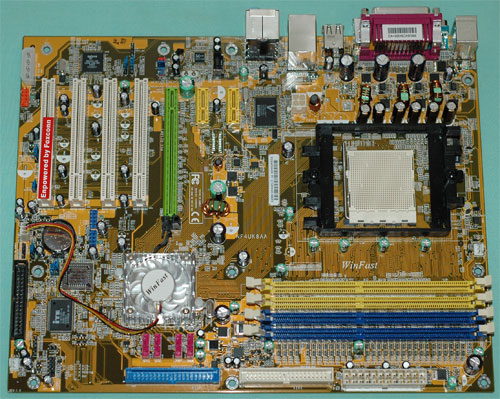
Original Link: https://www.anandtech.com/show/1727
nForce4 Ultra Roundup: Charting the Mainstream
by Wesley Fink on July 5, 2005 10:28 PM EST- Posted in
- Motherboards
In the last year, NVIDIA has risen to the top of the AMD Athlon 64 chipset market with their nForce series of single-chip solutions. As Socket 939 has matured, nForce4 has gained the dominant position in the AMD motherboard market. VIA, who has never been able to ship a competitive solution to NVIDIA's SLI, has moved down the pecking order somewhat, and is now more regarded as a value chipset, along with SiS, in the Athlon 64 market.
Recently, ATI has demonstrated some very interesting chipsets for the Athlon 64, and a Crossfire multi-GPU video solution to compete with NVIDIA's industry leading SLI. But the ATI chipsets and Crossfire boards have yet to ship, so they still remain a potential competitor for the future. At the low-end ULI, which is what remains of the former ALi chipset maker, has also been showing some very interesting chipsets for Athlon 64. There are new players emerging in the AMD market, but for now, the nForce4 chipset is King of the Athlon 64 hill. For that reason, people care quite a bit about how the various nForce4 motherboards compare in performance and features.
Several months ago, we took our first look at nForce4 production boards in nForce4 SLI Roundup: Painful and Rewarding. That look was very early in the nForce4 cycle, and we had our own share of problems getting all the features to work on those early nF4 boards. We persevered and did complete the roundup, finding a couple of boards that stood out from the crowd as Editor's Choices. This time around, we are looking at boards based on the single GPU nForce4 Ultra chipset. Keep in mind that nForce4 Ultra and nForce4 SLI are the exact same chipset, with the only difference being that the SLI function is enabled on the SLI version. There are no performance differences in the SLI and Ultra chipsets, or even the base nForce4 for that matter. These chipsets differ only in which features are available to the buyer - but they beat with the same heart.
The fact that the nForce4, nForce4 Ultra, and nForce4 SLI are identical core chips is important to anyone comparing board performance. SLI can be an expensive option, and if you don't require it, the nForce4 Ultra provides a single video solution with a chipset that performs exactly the same as the SLI chipset in single video. If you can give up a few more features, then the base nForce4 is an even cheaper solution that can give the same level of single video performance. This means that you can look at the performance of one member of the nForce4 family - an nForce4 SLI motherboard tested with single video, for example - and be fairly confident that the lower members of that family have a chipset that performs exactly the same. The different motherboard designs and chips selected for features might have some small impact on final performance for different nForce4 boards from the same manufacturer, but the differences will mainly be the available features on the various boards.
Processor Architecture
Another concern has surfaced in the last few months that should be a consideration for anyone shopping for an Athlon 64 motherboard - the processor factor. When we tested the nForce4 SLI boards, we used the 4000+ Clawhammer chip as our standard CPU. We also had done some testing with the early Winchester and Newcastle chips, which were based on the 90nm production process instead of the 130nm process used for Clawhammer. Overall, these early 90nm chips were mainly a die-shrink, and performance - and compatability - were much the same whether it be the Clawhammer, Winchester, or Newcastle.Recently, however, we have some new choices from AMD in Revision E chips and dual-core. These new Revision E parts support SSE3, are based on the 90nm process, and they do not always behave as earlier chips did in the same motherboard. We saw this for ourselves in our Gold Editor's Choice MSI K8N Neo4/SLI. While we experienced outstanding overclocking with a Clawhammer chip, users with Venice/San Diego chips were experiencing perfectly miserable overclocking results. It has taken MSI some time to find a solution to this problem, but we are happy to report that a new BIOS has just been released that claims to fix the Venice issues on the MSI.
The point of this is that the newest Athlon 64 Revision E chips do behave differently than earlier Athlon 64 chips in some boards. This is likely a temporary concern as the market adjusts to the newest CPU architectures, but it is a factor that should be considered.
This becomes an even larger issue with the new Manchester/Toledo dual-core chipsets. The Athlon 64 X2 joins two Venice or San Diego cores on a single CPU. These Revision E X2 dual-core CPUs (the 4200+, 4400+. 4600+, and 4800+) generally will work in any Socket 939 board. However, you will certainly need at least a BIOS upgrade. Most of the major manufacturers have quickly brought the needed BIOS upgrades to market, but if you plan to run a dual-core chip, you need to check before you buy.
We approached these issues in this roundup by continuing our benchmarks with the Clawhammer-based 4000+ processor - to allow the greatest comparison to earlier motherboard reviews. However, we also checked each board with a Manchester 90nm 4200+ CPU. This required finding the latest BIOS for x2 support, which we have also listed in the Motherboard Features chart for each board. This tells you the earliest BIOS revision that has been said by the manufacturer to support the X2 dual core chips.
It should also be mentioned that AMD has implemented a hidden feature in Revision E processors, namely additional memory ratios that can be implemented in BIOS. As we had seen on the Abit motherboard in this roundup, a Revision E chip adds 433, 466, and 500 options to the available memory ratios. This has to be coded in the BIOS to be available, but the new asynchronous ratios are a feature of the Revision E Memory Controller. We identified 2 boards, the Abit and DFI, that correctly implemented this function with the Rev. E chips and included that information in the feature table.
The good news is that just about any Socket 939 motherboard can run dual-core, and every motherboard in this roundup had a BIOS very recently available to support AMD x2 processors. But you will more than likely need a BIOS update.
How to Update BIOS for Dual-Core if You Have Dual-Core Only
This brings up the nagging question that is always asked when BIOS upgrades are required for certain CPUs. What do you do if you have a board that needs a BIOS upgrade for dual-core and you only have a dual-core chip? We asked AMD this question and was given the following reply:"If the BIOS you are working with (original BIOS in the board) supports a rev E single core (AKA... 90nm as most new boards should), it will allow you to flash the BIOS to a BIOS that supports rev E dual core. In my experience, a DC processor with single core rev E support will run fine, but only as a single core. If the BIOS doesn't support rev E (In other words, you may have a good board, but the BIOS is pretty old), you will likely need to install a pre-rev E (AKA-130nm) AMD processor to flash the BIOS.
I'm told that if a customer can't flash their BIOS, many mobo vendors will mail out the BIOS chip to them (if it's not soldered down, obviously)."
The Motherboard Test Suite
One of the ongoing concerns at AnandTech has been the tight clustering of performance results in our recent motherboard tests. In general, it is rare to see really wide variations in stock performance with motherboards these days. This has been made even clearer by the AMD Athlon 64 CPU, which has the memory controller on the CPU itself, removing another variable from the chipset equation. This is not bad news for buyers, since more consistent performance at stock speeds makes choosing a motherboard an easier task. Readers have pointed out that we need to do more tests that really differentiate boards, and we have been working on updates to our tests.First and foremost, we have been including overclocking tests and memory stress testing for some time - simply because motherboards can vary a great deal in these capabilities. This tells you which motherboards overclock well and which ones are poor, and even if you don't ever plan to overclock, the ability of a motherboard to run at much higher than stock speeds tells you something about the quality of components used in a motherboard. Good overclockers generally use better components and are able to regulate power on the board better, so the good overclocking boards often make sense to buy even if you will never overclock. You can reasonably expect better stability and a longer service life.
As you will see in the overclocking tests on these nF4 Ultra motherboards, there is a huge variation in overclocking performance among the seven boards. Some of the boards did very well, others claimed to be aimed at the enthusiast, and then fell short in providing the controls that the enthusiasts demand for overclocking. One well-known overclocking brand turned in a dismal performance, raising questions about the directions of that company. The overclocking tests are revealing, and in this roundup in particular, they truly differentiate the boards.
Features are increasingly important in motherboards these days as well. With USB, Firewire, IDE, SATA controllers, RAID, LAN, and audio commonly found on top-line motherboards, you are buying much more than sockets for a processor and memory. There are potentially great variations in performance of these features, which could be very important for certain uses of the board. AnandTech has done a good job of detailing these features in past motherboard reviews, but we actually began testing and comparing those features in our nForce4 SLI roundup in February. When we have already tested a particular chip or specific feature in past reviews, we do not repeat the tests. There are really very few options being used with nForce4 chipsets, so most of the feature chips seen in this review have already been tested.
We also added iPeak storage tests to the motherboard suite in February. The SiS 180 was the only new chip in this roundup, so we added the results to our previous test data. If you are interested in how storage performance compares, please refer to the SLI review storage section and recent storage tests on SATA II drives.
USB 2.0 and Firewire 400/800 throughput was also measured with a new test developed for motherboard testing beginning in February. Basically, we create a RAM disk in Windows XP, write a standard test file to the RAM disk, then copy the file from the RAM disk to a USB 2.0, Firewire 400 or Firewire 800 connected hard drive. We time the copy from RAM disk to the connected drive with a timer program developed by our IT Manager. USB 2.0 is integrated in the NVIDIA chipset, and the Agere was the only new Firewire chips found in these reviews. You should refer to the Firewire and USB tests results to see how the various chips compare in performance.
We first compared Ethernet in the nForce4 SLI roundup using the Windows 2000 DDK to connect two computers with a CAT 6 crossover cable. We then use a standard host computer as the server and measure the transmission rate and CPU overhead at the client side, which was our test motherboard. We clearly demonstrated the advantages of PCIe over PCI gigabit Ethernet in those benchmarks, and we suggest that you look for PCIe LAN if LAN speed is an important feature to you. Frankly, most users will not come close to taxing regular PCI LAN with broadband internet, but if large file transfers over a gigabit LAN are part of your work routine, then PCIe LAN will be faster. If your LAN is slower than Gigabit, you will see no performance difference between PCI and PCIe LAN.
Audio is an area that is still under development and we will be including additional tests in future motherboard testing. We had one new configuration in this roundup - the Abit audio card - and we ran the industry standard RightMark benchmark suite for CPU utilization or overhead to compare to other solutions.
FutureMark 3DMark 2005 and 3DMark 2003 are useful for testing SLI and will be continued in SLI motherboard testing, but they provided little additional information in single video testing with the same video card. Therefore, we have not included these mostly GPU dependent benchmarks in these motherboard tests. We continued Winstones 2004 for Business and Multimedia, PCMark04, and AutoGK for media encoding. Games are now more heavily weighted toward the most current games with Half Life 2, Far Cry, Doom 3, and Unreal Tournament 2004. Aquamark 3, which is better known as a benchmark than the game on which it is based, is also continued. Return to Castle Wolfenstein-Enemy Territory and Quake 3 have been retained primarily because of their sensitivity to memory performance. It is also a useful reference to include Open GL-based games with so many new game offerings based on Direct X or sporting DX9 front ends.
Memory tRAS Recommendations
In past reviews, memory bandwidth tests established that a tRAS of 10 was optimal for the nForce3 chipset and a tRAS setting of 11 or 12 was generally best for nForce2. In the first memory stress test of a production nForce4 board, tRAS timings were first tested with memtest86, a free diagnostic program with its own boot OS that will boot from either a floppy disk or optical disk. Bandwidth of OCZ PC3200 Platinum Rev. 2, based on Samsung TCCD chips, was measured from tRas 5 to tRAS 11 to determine the best setting.| Memtest86 Bandwidth DFI nForce4 with Athlon 64 4000+ |
|
| 5 tRAS | 2191 |
| 6 tRAS | 2242 |
| 7 tRAS | 2242 |
| 8 tRAS | 2242 |
| 9 tRAS | 2141 |
| 10 tRAS | 2141 |
| 11 tRAS | 2092 |
The best bandwidth was achieved with this combination of nForce4/4000+/TCCD in the 6 to 8 range, so a mid-value tRAS of 7 was chosen for all tests. It appears that optimal tRAS timings may also be memory dependent on the nForce4, so we recommend a quick series of memtest86 to establish the optimum tRAS timings for other memories.
The Roundup
The seven motherboards in this roundup represent a broad range of available motherboards based on the nForce4 Ultra chipset. Also, keep in mind that the four SLI motherboards tested in nForce4 SLI Roundup: Painful and Rewarding are also available in cheaper nForce4 Ultra versions. Since the DFI nForce4 SLI was the co-winner of the SLI Gold Editors Choice and is readily available in an nForce4 Ultra version using the same layout and BIOS, we ran the same benchmarks on this board and included results for the nF4 Ultra board in this roundup. You can also find a launch review of the DFI Ultra and SLI chipsets at DFI nForce4: SLI and Ultra for Mad Overclockers.The four boards in the SLI roundup should perform the same as the Ultra versions of the same board running a single video card. The SLI and Ultra chipsets are the same chipset with different features enabled. You can see this clearly in the fact that early DFI nF4 Ultra boards could be easily modified to SLI by closing a component pair as we showed in Morphing nForce4 Ultra into nForce4 SLI. This means that you can compare single video results from our nForce4 SLI roundup if you are considering purchasing an nF4 Ultra version of the Asus, Gigabyte or MSI.
The boards in the roundup cover a very wide range of selling prices, from the clustering of the Chaintech/Foxconn/ECS/Epox/Biostar in the $92 to $112 range, the DFI at about $135 to the high-end Abit Fatality at $185. Included in the roundup are the Chaintech VNF4 Ultra, Winfast (Foxconn) NF4UK8AA, ECS KN1 Extreme, Epox 9NPA+, Biostar NF4UL-A9, and Abit Fatal1ty AN8. Test results are also included for the DFI LANParty UT nF4 Ultra-D, which was reviewed in DFI nForce4: SLI and Ultra for Mad Overclockers.
Abit Fatal1ty AN8: Features and Layout
| Specification | Abit Fatal1ty AN8 |
| CPU Interface | Socket 939 Athlon 64 |
| Chipset | nForce4 Ultra (single chip) |
| BUS Speeds | 200MHz to 410MHz (in 1MHz increments) |
| PCI/AGP Speeds | Asynchronous (Fixed) |
| PCI Express | 100MHz to 145MHz in 1MHz increments |
| Core Voltage | Auto, 1.5V to 1.85V in 0.025V increments (with 4000+ | CPU Ref Voltage | +10mv to +60mv, -10mv to -60mv in 10mv increments |
| DRAM Voltage | Auto, 2.5V to 2.8V in 0.05V increments |
| DDR Ref Voltage | +10mv to +70mv, -10mv to -50mv in 10mv increments |
| Chipset Voltage | 1.5V to 1.8V in 0.05V increments |
| Hyper Transport Ratios | Auto, 1X to 5X in 1X increments |
| LDT Bus Transfer | 16/16, 16/8, 8/16, 8/8 |
| LDT Voltage | 1.25V to 1.4V in 0.05V increments |
| PCI Synchronization | Auto, To CPU, 33.33MHz |
| CPU Ratios | Auto, 4x to 20x in 0.5x increments |
| DRAM Speeds | Auto, DDR200, DDR266, DDR333, DDR400 (Plus DDR433, 466, 500 with Rev. E Processor) |
| Memory Command Rate | Auto, 1T, 2T |
| Memory Slots | Four 184-pin DDR Dual-Channel Slots Unbuffered ECC or non-ECC Memory to 4GB Total |
| Expansion Slots | 1 x16 PCIe Slots 2 x1 PCIe 3 PCI Slots |
| Onboard SATA | 4-Drive SATA 2 by nF4 |
| Onboard IDE | Two Standard NVIDIA ATA133/100/66 (4 drives) |
| SATA/IDE RAID | 4-Drive SATA 2 PLUS 4-Drive IDE (8 total) Can be combined in RAID 0, 1 |
| Onboard USB 2.0/IEEE-1394 | 10 USB 2.0 ports supported nF4 2 1394A FireWire ports by TI TSB43AB22A |
| Onboard LAN | PCIe Gigabit Ethernet by Vitesse VSC8201RX PHY |
| Onboard Audio | Audiomax 7.1 Audio Card with Realtek ALC850 8-Channel codec with 6 UAJ audio jacks, CD-in, front audio, and optical SPDIF |
| Other Features | AMD Dual-Core (X2) Support with 1.5 BIOS |
| BIOS | Award 1.5 (6/21/05) |
The Abit Fatal1ty AN8 is a member of the Fatal1ty series of motherboards aimed at gamers. Abit claims that everything about the Fatal1ty boards is beefed up for utmost stability in gaming situations. This "beefing-up" includes a special dual-fan OTES cooling system for the power transistors, and a dual-fan cooling device for RAM that Abit calls OTES RAMflow. These are two of the biggest heat-generating areas in modern motherboards and the Abit approach is noteworthy. With this attention to features that matter a great deal to the Enthusiast, we have great expectations of the overclocking abilities of the Abit Fatal1ty. Abit also has announced an SLI version of the Fatal1ty AN8, which adds dual-video NVIDIA SLI capabilities to the AN8 feature set.
The other side of the "beefed-up" Abit is the cost, as the Fatal1ty AN8 is by far the most expensive nForce4 Ultra motherboard in this roundup with a street price of about $185. With that kind of price, buyers will certainly expect the Fatal1ty AN8 to be head and shoulders above the other boards in the roundup. If this is too rich for your blood, then Abit also sells the more basic AN8 board for about $100 street price.
Boards have been improving in basic layout for the last few years, and the Abit is generally an agreeable layout - with a couple of "gotchas". Many no longer care about floppy drives, but if the floppy is important to you, the connector location at the bottom of the board will be a stretch in tall cases. The lower right-hand IDE connectors are the edge type, and we would advise you to connect them before mounting the board. Since they are often behind drives, you won't be able to reach these IDE-edge connectors otherwise in some case designs.
The 24-pin ATX and 4-pin 12V connectors are at the board edges, where they work best. It is also a pleasure to see Abit place the 4 SATA connectors and PCIe slot where they will not interfere with each other. Board makers seem to be giving more thought to IDE placement lately, but SATA connectors are increasingly a mess to work with in many motherboards. Top video cards are big, and SATA connectors behind a PCIe slot can make a decent board a nightmare if you're mounting SATA devices. Abit, fortunately, gave some thought to SATA placement.
While it's not pictured, the included "Audio Max" dedicated sound card fits in the first slot - just above the 2 PCIe x1 slots. This is a good location, which clusters sound connectors near the rear panel. While the Audio Max is powered by the very common Realtek ALC850 codec, isolating the sound hardware, like we have seen DFI do on similar dedicated sound cards, should pay off in lower noise and reduced CPU overhead for the audio hardware.
Abit boards usually have quite a few fan connectors, and this would certainly be expected on a board geared to gamers, who may have many devices to cool. Unfortunately, there are just 3 fan headers on board; after the North Bridge and CPU, there is just the System Fan header. That means that if you have a Power Supply with a fan-monitoring plug, there are no spares on the Abit. A "gamers" board really needs a few more fan headers.
The storage area is basic nForce4, which is pretty good by itself, but there are no additional RAID controllers, which you might expect on a $185 board.
The BIOS options are typically Abit, meaning that they are very good. There's just about any BIOS adjustment that you might want. One particular disappointment are the memory voltage controls, which only extend to 2.8V. Abit has fixed this option in other versions of the AN8 - the Ultra and SLI extend to 3.55V for super high-voltage 2-2-2 memory like OCZ VX and Mushkin Redline. For that reason, the other Abit AN8 boards are a better choice for the Athlon 64 enthusiast than this early AN8 Fatal1ty. The Abit AN8 Fatal1ty is one of the two boards in this roundup that supports the additional 433, 466, and 500 memory speed options on an AMD Rev. E processor.
Abit Fatal1ty AN8: Overclocking and Stress Testing
FSB Overclocking Results
| Front Side Bus Overclocking Testbed | |
| Abit Fatal1ty AN8 | |
| Processor: | Athlon 64 4000+ (2.4GHz, 1MB Cache) |
| CPU Voltage: | 1.5375V (default 1.50V) |
| Cooling: | Thermaltake Silent Boost K8 Heatsink/Fan |
| Power Supply: | OCZ Power Stream 520W |
| Memory: | OCZ PC3200 EL Platinum Rev. 2 (Samsung TCCD Memory Chips) |
| Hard Drive: | Seagate 120GB 7200RPM SATA 8MB Cache |
| Maximum OC: (Standard Ratio) |
234x12 (Auto HT, 2-3-3-7, 1T, 2.8V) 2808MHz (+17%) |
| Maximum FSB: (Lower Ratio) |
250x11 (2750MHz) (4X HT, 2.5-3-3-7, 2.7V) (1:1 Memory, 1T, 2 DIMMs in DC mode) (+25% Bus Overclock) |
Abit almost invented the concept of the overclocker's motherboard, so we have to wonder what went wrong in the design of the AN8. The board is OK at stock speed overclocking at 234, but several other boards in this roundup do better with the same CPU. The real disappointment, however, is 1:1 overclocking with a reduced CPU multiplier. No matter what we did, we could not coax the Fatal1ty AN8 above a 250 CPU clock setting. The DFI and Epox both handle 300 or better just fine, but the Abit has something holding it back.
Perhaps this can be corrected with a BIOS upgrade, since we also played a bit with asynchronous overclocking on the Abit with the new 433, 466, 500 ratios with Rev. E. The Abit reached around 280 in some of those setups, but 1:1 was much poorer. Until Abit is able to fix this issue with 1:1 overclocking, it should be clear that there are better choices for an nForce4 board if overclocking is your goal.
Memory Stress Test Results:
Memory stress tests look at the ability of the Abit An8 Fatal1ty to operate at the officially supported memory frequency, at the best performing memory timings that our standard OCZ PC3200 Platinum Rev. 2 will support. Memory stress testing was conducted by running 1:1 at DDR400 with 2 DIMM slots operating in Dual-Channel mode.| Stable DDR400 Timings - One Dual-Channel (2/4 DIMMs populated) |
|
| Clock Speed: | 200MHz |
| CAS Latency: | 2.0 |
| RAS to CAS Delay: | 2T |
| RAS Precharge: | 7T |
| Precharge Delay: | 2T |
| Command Rate: | 1T |
The Abit was completely stable with 2 DDR modules in Dual-Channel at the settings of 2-2-2-7 at default voltage. All of the nF4 motherboards in this roundup were able to reach these fast timings with OCZ PC3200 Platinum Rev.2 memory.
Filling all four available memory slots is more strenuous on the memory subsystem than testing 2 DDR modules on a motherboard
| Stable DDR400 Timings - 4 DIMMs (4/4 DIMMs populated) |
|
| Clock Speed: | 200MHz |
| CAS Latency: | 2.0 |
| RAS to CAS Delay: | 2T |
| RAS Precharge: | 7T |
| Precharge Delay: | 2T |
| Command Rate: | 2T |
The Abit AN8 Fatal1ty was completely stable at 2-2-2-7 memory timings, but the Command Rate did need to be lowered to 2T. This is a function of the on-chip Athlon 64 memory controller. We also found that the new Rev. E chips with an updated memory controller required 2T for 4 DS DIMMs.
Biostar NF4UL-A9: Features and Layout
| Specification | Biostar NF4UL-A9 |
| CPU Interface | Socket 939 Athlon 64 |
| Chipset | nForce4 Ultra (single chip) |
| BUS Speeds | 200MHz to 300MHz (in 1MHz increments) |
| PCI/AGP Speeds | Asynchronous (Fixed) |
| PCI Express | Fixed |
| Core Voltage | Startup, 1.2V to 1.625V in 0.025V increments |
| DRAM Voltage | Default, 2.7V, 2.8V, 2.9V |
| Chipset Voltage | NA |
| Hyper Transport Ratios | Auto, 1x, 2x, 3x, 4x, 5x |
| LDT Bus Transfer | 16/16, 16/8, 8/16, 8/8 |
| CPU Ratios | Startup, 4x to 25x in 1x increments |
| DRAM Speeds | Auto, 100, 133, 166, 200 |
| Memory Command Rate | Auto, 1T, 2T |
| Memory Slots | Four 184-pin DDR Dual-Channel Slots Unbuffered ECC or non-ECC Memory to 4GB Total |
| Expansion Slots | 1 x16 PCIe Slots 1 Xtreme Graphics Port (AGP 8X Form Factor) 2 x1 PCIe 3 PCI Slots |
| Onboard SATA | 4-Drive SATA 2 by nF4 |
| Onboard IDE | Two Standard NVIDIA ATA133/100/66 (4 drives) |
| SATA/IDE RAID | 4-Drive SATA 2 PLUS 4-Drive IDE (8 total) Can be combined in RAID 0, 1 |
| Onboard USB 2.0/IEEE-1394 | 10 USB 2.0 ports supported nF4 2 1394A FireWire ports by VIA VT6307 |
| Onboard LAN | Gigabit PCIe Ethernet by Vitesse VXC8201 PHY |
| Onboard Audio | Realtek ALC850 8-Channel codec with 6 UAJ audio jacks, CD-in, front audio, and optional coaxial SPDIF cable |
| Other Features | Dual-Core (x2) Support with BIOS nf4ua614 |
| BIOS | nf4ua614 |
Biostar took a different approach in the design of their nForce4 Ultra board. If you look closely at the video card slots, you will see how unique this board really is.
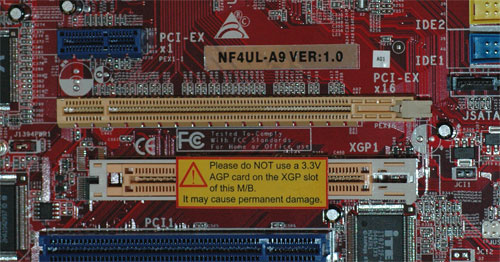
Even though it is not a full 8X AGP slot, the Biostar is still a unique and useful choice for those having AGP cards that they are not ready to replace. Those buyers can go to the Biostar with their current AGP card and still have the option of moving to PCIe on the same board at some time in the future. Since nForce4 does not support AGP, the Biostar allows AGP users to choose an nForce4 board anyway.
The Biostar is basically a sound board layout, particularly for a lower-priced nF4 motherboard. The 4-pin 12V power connector requires snaking the 4-pin power cable over or around the CPU, a design that many others also use. The board edge is a better location, and fortunately, the 24-pin ATX cable does reside on a board edge where it belongs. The 4 SATA connectors are a tight fit next to the PCIe slot, but they will work - even with a very long PCIe video card with dual power connectors.
The floppy connector is on the lower right edge of the board, which is certainly a better location than the bottom of the board, but still a longer reach than the preferred upper right location. Turning the IDE connectors sideways allows them to fit on the right edge near the center of the board. In most case designs, this will work fine, but a tall case with drives above the board chamber might require snaking IDE cables over DIMMs - not ideal for air flow.
BIOS controls on the Biostar were a pleasant surprise for an entry-level nForce4 Ultra motherboard. Just about every adjustment that you need for overclocking is here, including a useful vDIMM range to 2.9V, a wide CPU voltage adjustment range, and CPU ratio adjustments. The same goes for features, as our board even had dual Firewire ports controlled by a TI controller. Firewire is one of the first options to go when manufacturers build to a price point.
The only glaring omission is the lack of a standard SPDIF optical or coaxial out port. A board with 8-channel sound and 6 jacks should have a supplied SPDIF connector, not an optional feature.
We also ran into a very strange anomaly when benchmarking the XGP graphics slot. When we mounted an 8X AGP card and selected PCI as out boot video, the system booted just fine into Windows XP. However, the Gigabit LAN had mysteriously disappeared and no amount of searching for new devices would bring it back. We removed the AGP and reinstalled a PCIe video card and the Gigabit LAN was back. We hope that Biostar can find a way to correct this strange behavior in a future BIOS update.
Biostar NF4UL-A9: Overclocking and Stress Testing
FSB Overclocking Results
| Front Side Bus Overclocking Testbed | |
| Biostar NF4UL-A9 | |
| Processor: | Athlon 64 4000+ (2.4GHz, 1MB Cache) |
| CPU Voltage: | 1.50V (default 1.50V) |
| Cooling: | Thermaltake Silent Boost K8 Heatsink/Fan |
| Power Supply: | OCZ Power Stream 520W |
| Memory: | OCZ PC3200 EL Platinum Rev. 2 (Samsung TCCD Memory Chips) |
| Hard Drive: | Seagate 120GB 7200RPM SATA 8MB Cache |
| Maximum OC: (Standard Ratio) |
223x12 (Auto HT, 2-3-2-7, 1T, 2.7V) 2677MHz (+11.5%) |
| Maximum FSB: (Lower Ratio) |
232x11 (2552MHz) (Auto HT, 2.5-3-3-7, 2.7) (1:1 Memory, 1T, 2 DIMMs in DC mode) (+16% Bus Overclock) |
With all of the excellent adjustments for overclocking, we were hoping for some nice performance boosts with the Biostar. Unfortunately, that was not to happen, as the board design did not match the controls provided by Biostar. Overclocking was about the worst in the roundup, with just an 11.5% boost on a CPU that can do 20% overclocking on some boards. The lower multiplier didn't help much, allowing just a 16% boost.
Memory Stress Test Results:
Our memory stress test measured the ability of the Biostar to operate at its officially supported memory frequency (400MHz DDR), at the lowest memory timings that OCZ PC3200 Platinum Rev. 2 modules will support. All DIMMs used for stress testing were 512MB double-sided (or double-bank) memory. To make sure that memory performed properly in Dual-Channel mode, memory was only tested using either one dual-channel (2 DIMMs) or 2 dual-channels (4 DIMMs).| Stable DDR400 Timings - One Dual-Channel (2/4 DIMMs populated) |
|
| Clock Speed: | 200MHz |
| CAS Latency: | 2.0 |
| RAS to CAS Delay: | 2T |
| RAS Precharge: | 7T |
| Precharge Delay: | 2T |
| Command Rate: | 1T |
Using two DIMMs in Dual-Channel 128-bit mode, the memory performed in all benchmarks at the fastest 2-2-2-7 timings, at default 2.6V voltage.
Tests with 4 DS DIMMs on an AMD Athlon 64 system are more demanding, since AMD specifies DDR333 for this combination. However, most AMD Athlon 64 motherboards combined with recent AMD processors (the memory controller is on the AMD CPU) have been able to handle 4 DIMMs at DDR400.
| Stable DDR400 Timings - 4 DIMMs (4/4 DIMMs populated) |
|
| Clock Speed: | 200MHz |
| CAS Latency: | 2.0 |
| RAS to CAS Delay: | 2T |
| RAS Precharge: | 7T |
| Precharge Delay: | 2T |
| Command Rate: | 2T |
Tests with all four DIMM slots populated on the Biostar nForce4 boards required a 2T Command Rate with 4 DS DIMMs in two dual channels. This is the pattern seen on other top-performing Socket 939 boards, and is a limitation of the AMD on-chip memory controller. Additional voltage did not help and DDR400 with 4 DS DIMMs still required a Command Rate as we have seen on other nF4 boards.
Chaintech VNF4-Ultra: Features and Layout
| Specification | Chaintech VNF4-Ultra |
| CPU Interface | Socket 939 Athlon 64 |
| Chipset | nForce4 Ultra (single chip) |
| BUS Speeds | 200MHz to 400MHz (in 1MHz increments) |
| PCI/AGP Speeds | Asynchronous (Fixed) |
| PCI Express | 100MHz to 145MHz in 1MHz increments |
| Core Voltage | Auto, 0.90V to 1.70V in 0.025V increments |
| DRAM Voltage | Default, 2.7V, 2.8V, 2.9V |
| Chipset Voltage | Default, 1.6V, 1.65V, 1.7V |
| Hyper Transport Ratios | 1x to 5x in 1x increments |
| LDT Bus Transfer | 16/16, 16/8, 8/16, 8/8 |
| LDT Voltage | Normal, +0.1V, +0.2V, +0.3V |
| CPU Ratios | Auto, 4x to 25x in 1x increments |
| DRAM Speeds | Auto, 100, 133, 166, 200 |
| Memory Command Rate | Auto, 1T, 2T |
| Memory Slots | Four 184-pin DDR Dual-Channel Slots Unbuffered Memory to 4GB Total |
| Expansion Slots | 1 x16 PCIe Slots 2 x1 PCIe 3 PCI Slots |
| Onboard SATA | 4-Drive SATA 2 by nF4 |
| Onboard IDE | Two Standard NVIDIA ATA133/100/66 (4 drives) |
| SATA/IDE RAID | 4-Drive SATA 2 PLUS 4-Drive IDE (8 total) Can be combined in RAID 0, 1 |
| Onboard USB 2.0/IEEE-1394 | 10 USB 2.0 ports supported nF4 No Firewire |
| Onboard LAN | Gigabit PCIe Ethernet by Vitesse VSC8201 PHY |
| Onboard Audio | Realtek ALC850 8-Channel codec with 6 UAJ audio jacks, CD-in, front audio, and optical SPDIF |
| Other Features | AMD Dual-Core (X2) Support with 5/18 Beta BIOS |
| BIOS | Award 6/03/2005 |
The Chaintech was one of the motherboards that we had looked forward to testing. It is very inexpensive, and the last Chaintech that we tested, the Socket 754 VNF3-250, was an Editors Choice for value. Chaintech has repeated an outstanding selection of useful overclocking adjustments in the VNF4-Ultra BIOS. The features are also first rate for an Ultra board selling for $89 street price, with Firewire being the only missing feature of importance to some buyers. Even the excellent NVIDIA "any-drive" RAID for SATA 2 and IDE is fully supported, along with the standard NVIDIA chipset-based Firewall and LAN features. Chaintech has also implemented a really nice boot screen option. When selected in the BIOS, the boot screen shows post codes during boot so that you can see exactly what is going on and where problems might be.
While a little smaller than the other nF4 Ultra boards, Chaintech has compensated with a different layout that works very well in most cases. The 4 DIMM slots move to the top, with the Socket 939 moved towards the center of the board. This allows Chaintech to place almost all the storage connectors on the right edge of the board where they usually work best. SATA and IDE are well clear of the PCIe slot. The nF4 floppy connector is at the lower right of the board - not the best location, but much better than at the bottom of the board.
The only real compromise that Chaintech made with the smaller board was placing the 24-pin ATX and the 4-pin 12V between the CPU and rear panel connectors. No matter how you run the bulky 24-pin cable, it gets in the way of something - memory or CPU or IDE/SATA connections - and none of the routing options is really a great choice. Chaintech builds to a price point, and if this is the concession that had to be made for performance, we will find a way to live with it. That doesn't mean that we have to like it though.
At first, we thought that Chaintech had omitted an optical or coaxial SPDIF port, but looking closer, we found that the top left audio port (the blue connector) does double-duty as an optical SPDIF out port.
When we first received the Chaintech for evaluation, it was supplied with a passive heatsink for the single-chip nForce4 Ultra chipset. Chaintech sent an announcement that they had updated the design for active chipset cooling due to high temperatures with the nF34 chipset. Soon thereafter, we received an active cooling kit for the VNF4-Ultra that was a very easy installation. Chaintech tells us that current boards should be equipped with active cooling for the chipset.
Chaintech VNF4-Ultra: Overclocking and Stress Testing
FSB Overclocking Results
| Front Side Bus Overclocking Testbed | |
| Chaintech VNF4-Ultra | |
| Processor: | Athlon 64 4000+ (2.4GHz, 1MB Cache) |
| CPU Voltage: | 1.55V (default 1.50V) |
| Cooling: | Thermaltake Silent Boost K8 Heatsink/Fan |
| Power Supply: | OCZ Power Stream 520W |
| Memory: | OCZ PC3200 EL Platinum Rev. 2 (Samsung TCCD Memory Chips) |
| Hard Drive: | Seagate 120GB 7200RPM SATA 8MB Cache |
| Maximum OC: (Standard Ratio) |
237x12 (4X HT, 2.5-3-2-7, 1T, 2.8V) 2844MHz (+18.5%) |
| Maximum FSB: (Lower Ratio) |
245x11 (2695MHz) (4X HT, 2.5-3-3-7, 2.8V) (1:1 Memory, 1T, 2 DIMMs in DC mode) (+22.5% Bus Overclock) |
The Chaintech VNF4-Ultra turned out to be a pale performer compared to the earlier Socket 754 nF3 Chaintech. While the VNF4 was excellent at overclocking at stock multipliers, its top end at reduced multipliers was a disappointing 245 clock speed, or 22.5%. This compares to over 300 clock speed with the top boards in this roundup.
That is not to say that the Chaintech is a poor overclocker. At stock multiplier, it can reach as high as just about any board in this roundup at a 18.5% overclock. However, if your approach to overclocking is to get the most from your memory by lowering multipliers and cranking up the memory speed, then you should choose another nForce4 Ultra motherboard.
Memory Stress Test Results:
Our memory stress tests measure the ability of the VNF4-Ultra to operate at its officially supported memory frequency (400MHz DDR), at the lowest memory timings that OCZ PC3200 Platinum Rev. 2 modules will support. All DIMMs used for stress testing were 512MB double-sided (or double-bank) memory. To make sure that memory performed properly in Dual-Channel mode, memory was only tested using either one dual-channel (2 DIMMs) or 2 dual-channels (4 DIMMs).| Stable DDR400 Timings - One Dual-Channel (2/4 DIMMs populated) |
|
| Clock Speed: | 200MHz |
| CAS Latency: | 2.0 |
| RAS to CAS Delay: | 2T |
| RAS Precharge: | 7T |
| Precharge Delay: | 2T |
| Command Rate: | 1T |
Using two DIMMs in Dual-Channel 128-bit mode, the memory performed in all benchmarks at the fastest 2-2-2-7 timings, at default 2.6V voltage.
Tests with 4 DS DIMMs on an AMD Athlon 64 system are more demanding, since AMD specifies DDR333 for this combination. However, most AMD Athlon 64 motherboards combined with recent AMD processors (the memory controller is on the AMD CPU) have been able to handle 4 DIMMs at DDR400.
| Stable DDR400 Timings - 4 DIMMs (4/4 DIMMs populated) |
|
| Clock Speed: | 200MHz |
| CAS Latency: | 2.0 |
| RAS to CAS Delay: | 2T |
| RAS Precharge: | 7T |
| Precharge Delay: | 2T |
| Command Rate: | 2T |
Tests with all four DIMM slots populated on the Chaintech required a 2T Command Rate with 4 DIMMs in two dual channels. This is the pattern seen on other top-performing Socket 939 boards. There was no problem running 4 DS DIMMs at DDR400 at the same aggressive 2-2-2-7 settings, which worked well with 2 DIMMs.
DFI LANParty UT nF4 Ultra-D: Features and Layout
| Specification | DFI LANParty UT nF4 Ultra-D |
| CPU Interface | Socket 939 Athlon 64 |
| Chipset | nForce4 Ultra (single chip) |
| BUS Speeds | 200MHz to 456MHz (in 1MHz increments) |
| PCI/AGP Speeds | Asynchronous (Fixed) |
| PCI Express | 100MHz to 145MHz in 1MHz increments |
| Core Voltage | Auto, 0.8V to 1.55V in 0.025V increments (Normal) PLUS *104%, 110%, 113%, 123%, 126%, 133%, 136% (Special - to 1.85V) |
| CPU Startup Voltage | Startup, 0.825V to 1.550V in 0.025V increments |
| DRAM Voltage | 2.5V to 3.2V in 0.1V increments (3V jumper) 2.5V to 4.0V in 0.1V increments (5V jumper) |
| Chipset Voltage | 1.5V, 1.6V, 1.7V, 1.8V |
| Hyper Transport Ratios | Auto, 1.0, 1.5, 2.0, 2.5, 3.0, 4.0, 5.0 |
| LDT Bus Transfer | 16/16, 16/8, 8/16, 8/8 |
| LDT Voltage | 1.2V, 1.3V, 1..4V, 1.5V |
| CPU Ratios | Auto, 4x to 25x in 0.5x increments |
| Cool'n'Quiet MAX FID | Auto, 8.0 to 13.0 in 0.5x increments |
| DRAM Speeds | Auto, 100, 120, 133, 140, 150, 166, 180, 200 (Plus DDR433, 466, 500 with Rev. E Processor) |
| Memory Command Rate | Auto, 1T, 2T |
| Memory Slots | Four 184-pin DDR Dual-Channel Slots Unbuffered ECC or non-ECC Memory to 4GB Total |
| Expansion Slots | 2 x16 PCIe Slots 1 x4 PCIe 1 x1 PCIe 2 PCI Slots |
| SLI Setup | Six 16-pin Jumper Blocks |
| Onboard SATA | 4-Drive SATA 2 by nF4 |
| Onboard IDE | Two Standard NVIDIA ATA133/100/66 (4 drives) |
| SATA/IDE RAID | 4-Drive SATA 2 PLUS 4-Drive IDE (8 total) Can be combined in RAID 0, 1 |
| Onboard USB 2.0/IEEE-1394 | 10 USB 2.0 ports supported nF4 2 1394A FireWire ports by VIA VT6307 |
| Onboard LAN | Dual Gigabit Ethernet PCIe by Vitesse VSC8201 PHY PCI by Marvel 88E8001 |
| Onboard Audio | Karajan Audio Module based on Realtek ALC850 8-Channel codec with 6 UAJ audio jacks, CD-in, front audio, and coaxial SPDIF In and Out |
| Other Features | AMD X2 Support with 5/10/2005 or higher BIOS Diagnostic LEDs, Power and Reset momentary switches |
| BIOS | Award 7/01/2005 Release |
The DFI LANParty UT nF4 Ultra-D was tested when it was launched in DFI nForce4: SLI and Ultra for Mad Overclockers. We also included the DFI LANParty nF4 SLI-DR in our SLI roundup in nForce4 SLI Roundup: Painful and Rewarding. This is significant because the designs of the Ultra and SLI versions of the DFI are exactly the same. Both board layouts are essentiallly the same - the only difference is the SLI chipset on the SLI and Ultra chipset on the Ultra. As we detailed in Morphing nForce4 Ultra into nForce4 SLI, the SLI and Ultra chipsets are exactly the same, with the SLI features turned on in the SLI chipset. NVIDIA has modified the nForce4 chipset, making it more difficult to convert the Ultra to nF4, but the principles are still the same.
For more information on the features or layout of the DFI, please refer to any of these aforementioned reviews.
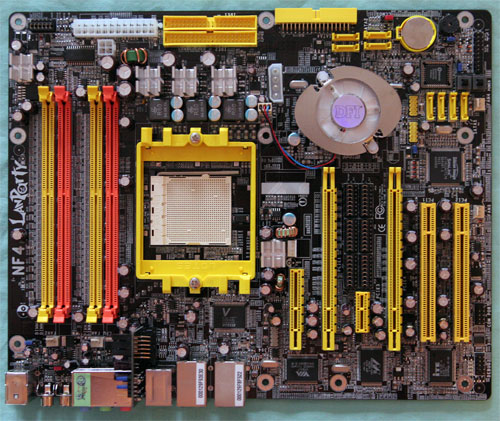
DFI LANParty nF4 SLI-DR: Overclocking and Stress Testing
Overclocking
| Front Side Bus Overclocking Testbed | |
| DFI LANParty nF4 SLI-DR | |
| Processor: | Athlon 64 4000+ (2.4GHz, 1MB Cache) |
| CPU Voltage: | 1.55V (default 1.50V) |
| Cooling: | Thermaltake Silent Boost K8 Heatsink/Fan |
| Power Supply: | OCZ Power Stream 520W |
| Memory: | OCZ PC3200 EL Platinum Rev. 2 (Samsung TCCD Memory Chips) |
| Hard Drive: | Seagate 120GB 7200RPM SATA 8MB Cache |
| Maximum OC: (Standard Ratio) |
238x12 (Auto HT, 2-3-2-7, 1T, 2.9V) 2856MHz (+19%) |
| Maximum FSB: (Lower Ratio) |
318x9 (2862MHz) (Auto HT, 2.5-4-3-7, 2.9V) (1:1 Memory, 1T, 2 DIMMs in DC mode) (+59% Bus Overclock) |
All benchmarks for the DFI LANParty UT nF4 Ultra-D were rerun with the updated drivers and test resolutions used in this roundup. Overclocking performance was essentially the same as we saw in the SLI roundup. The DFI was 2nd among the boards in Maximum OC at stock ratios, reaching 238x12. In Maximum FSB at lower multipliers, the DFI was #1 in the roundup, reaching 318x9.
Memory Stress Tests
| Stable DDR400 Timings - One Dual-Channel (2/4 DIMMs populated) |
|
| Clock Speed: | 200MHz |
| CAS Latency: | 2.0 |
| RAS to CAS Delay: | 2T |
| RAS Precharge: | 7T |
| Precharge Delay: | 2T |
| Command Rate: | 1T |
| Stable DDR400 Timings - 4 DIMMs (4/4 DIMMs populated) |
|
| Clock Speed: | 200MHz |
| CAS Latency: | 2.0 |
| RAS to CAS Delay: | 2T |
| RAS Precharge: | 7T |
| Precharge Delay: | 2T |
| Command Rate: | 2T |
ECS KN1 Extreme: Features and Layout
| Specification | ECS KN1 Extreme |
| CPU Interface | Socket 939 Athlon 64 |
| Chipset | nForce4 Ultra (single chip) |
| BUS Speeds | 200MHz to 400MHz (in 1MHz increments) |
| PCI/AGP Speeds | Asynchronous (Fixed) |
| PCI Express | Fixed |
| Core Voltage | Normal, +25mV to +375mV in 25mV increments (to 1.875V on 1.5V CPU) |
| DRAM Voltage | Auto, 2.55V to 3.11V in 0.08V increments |
| Chipset Voltage | NA |
| Hyper Transport Ratios | Auto, 1X to 5X in 1X increments |
| LDT Bus Transfer | 16/16, 16/8, 8/16, 8/8 |
| CPU Ratios | Startup, 4x to 25x in 0.5x increments |
| DRAM Speeds | Auto, 100, 133, 166, 200 |
| Memory Command Rate | Auto |
| Memory Slots | Four 184-pin DDR Dual-Channel Slots Unbuffered ECC or non-ECC Memory to 4GB Total |
| Expansion Slots | 1 x16 PCIe Slots 2 x1 PCIe 3 PCI Slots |
| Onboard SATA | 4-Drive SATA 2 by nF4 2 Drives by SiS 180 |
| Onboard IDE | Two Standard NVIDIA ATA133/100/66 (4 drives) |
| SATA/IDE RAID | 4-Drive SATA 2 PLUS 4-Drive IDE (8 total) Can be combined in RAID 0, 1 PLUS 2 Drives by SiS 180 RAID 0, 1 |
| Onboard USB 2.0/IEEE-1394 | 10 USB 2.0 ports supported nF4 2 1394A FireWire ports by TI TSB43AB22A |
| Onboard LAN | Dual Gigabit PCIe Ethernet Gigabit PCIe by Marvel 88E1111 PHY 10/100 PCI by Realtek RTL8100C |
| Onboard Audio | Realtek ALC850 8-Channel codec with 6 UAJ audio jacks, CD-in, front audio, Optical and Coaxial SPDIF Out |
| Other Features | AMD X2 Support with 1.1A or higher BIOS Slot LEDs, Power Transistor Fan and Duct |
| BIOS | Award 1.1A (6/02/05) |
ECS reserves the Extreme label for their top motherboards aimed at the computer enthusiast. While the Extreme boards have been very high on features, they have remained very affordable, often competing with boards that have much more modest feature sets. ECS decided some time ago that they wanted to go after the computer enthusiast; however, the path has been anything but a smooth one. As we have said in other reviews, it is one thing to aim for a board at the enthusiast market, but it is quite another to deliver the features and performance that enthusiasts really want.
Our last review of an ECS Extreme was in the Intel 915 roundup, where the ECS PF4 915P Extreme earned an Editors Choice in that huge roundup. For this roundup, we are taking a closer look at the ECS KN1 Extreme, based on the NVIDIA nForce Ultra chipset.
The ECS certainly has most of the BIOS options that an enthusiast is looking for. Memory voltage goes to 3.11V, which is significantly better than many top-name motherboards, which still have trouble supplying more than 2.8V as a memory voltage option. It would be better if options went to 3.5V, but in fairness, this range will provide the voltage needed for any memory except the high-voltage 2-2-2 OCZ VX and Mushkin Redline, which need 3.5V for best performance. Similarly, processor voltage options to +375mv are very adequate with today's CPUs, and the bus speeds to 400 and full range of processor ratios give users the option to make the most of the Athlon 64 capabilities. The only question that remains is whether or not the nice options mean anything on the KN1 Extreme; in other words, do they actually function?
As you can see in the picture, the color is certainly extreme on the all purple ECS motherboard. Board layout is absolutely superb, unless you happen to still use a floppy. Once again, we see the floppy connector at the very bottom of the board, which is a really difficult reach in a tall case. This poor floppy placement seemed to start with the NVIDIA Reference Board, but we wish that it would stop. In fairness, many don't use floppies any more and don't care, but if you are a floppy user, prepare for interesting cabling.
There is nothing to complain about in the rest of the layout as ECS did a very good job on the KN1 Extreme. The ATX 24-pin and 12V 4-pin power connectors are on board edges where they belong. The IDE ports are in the ideal position, the 6 SATA ports fully clear the PCIe slot, and the additional connectors are on the bottom edge of the board, outside of the slot area.
ECS also thoughtfully included both coaxial and optical SPDIF out connectors on the rear panel, which also features dual-LAN (gigabit PCIe and 10/100 PCI) connectors. Perhaps manufacturers could label their dual LAN connections because even though I have a 50/50 chance, I seem always to plug the 10/100 when I'm looking for the Gigabit LAN. ECS also features a lime-green shroud with cooling fan for the power transistors, a feature more typical of Abit than ECS. All-in-all, the layout, feature set, and BIOS options are right on target for the audience that ECS hopes to attract.
We should mention in passing that, at first, we couldn't find the CPU ratios in BIOS. After complaining to ECS that there were no ratios, they pointed us to the Power Management tab, where Hammer FID controls were located. This certainly was not an intuitive placement for CPU ratios, although we do get the logic that Hammer FID or ratios are there because of Cool'N'Quiet, which is definitely related to Power Management. In any event, the ratios are there in Power Management, so we might save you a bit of searching.
ECS KN1 Extreme: Overclocking and Stress Testing
FSB Overclocking Results
| Front Side Bus Overclocking Testbed | |
| ECS KN1 Extreme | |
| Processor: | Athlon 64 4000+ (2.4GHz, 1MB Cache) |
| CPU Voltage: | 1.55V (default 1.50V) |
| Cooling: | Thermaltake Silent Boost K8 Heatsink/Fan |
| Power Supply: | OCZ Power Stream 520W |
| Memory: | OCZ PC3200 EL Platinum Rev. 2 (Samsung TCCD Memory Chips) |
| Hard Drive: | Seagate 120GB 7200RPM SATA 8MB Cache |
| Maximum OC: (Standard Ratio) |
235x12 (Auto HT, 2-3-2-7, 1T, 2.85V) 2820MHz (+17.5%) |
| Maximum FSB: (Lower Ratio) |
235x11 (Auto HT, 2-3-2-7, 1T, 2.85V) 2585MHz (+17.5%) Lower Ratios reset to Stock Multiplier |
Reality bites when we begin overclocking the ECS KN1 Extreme, since the ratios that we had such a time finding really don't work very well. As long as we stay within about 1.5X of stock speed, the ratios work, but beyond that, the board resets whatever you set. That means that we couldn't get 10 or 9 to work with a 12X 4000+ CPU. The stock multiplier overclocking was competitive at 235 with top boards, but the inability to set ratios reliably had seriously limited bus overclocking. The best that we could do was the same 235 at 11, which we reached at stock 12X. This was really a disappointment for a board that we thought might break away as a great value. For stock performance, the ECS is fine; for modest overclocking, the ECS performs well; but for the enthusiast, the KN1 is anything but extreme.
Memory Stress Test Results:
Our memory stress test measured the ability of the ECS to operate at its officially supported memory frequency (400MHz DDR), at the lowest memory timings that OCZ PC3200 Platinum Rev. 2 modules will support. All DIMMs used for stress testing were 512MB double-sided (or double-bank) memory. To make sure that memory performed properly in Dual-Channel mode, memory was only tested using either one dual-channel (2 DIMMs) or 2 dual-channels (4 DIMMs).| Stable DDR400 Timings - One Dual-Channel (2/4 DIMMs populated) |
|
| Clock Speed: | 200MHz |
| CAS Latency: | 2.0 |
| RAS to CAS Delay: | 2T |
| RAS Precharge: | 7T |
| Precharge Delay: | 2T |
| Command Rate: | 1T |
Using two DIMMs in Dual-Channel 128-bit mode, the memory performed in all benchmarks at the fastest 2-2-2-7 timings at default 2.6V voltage.
Tests with 4 DS DIMMs on an AMD Athlon 64 system are more demanding, since AMD specifies DDR333 for this combination. However, most AMD Athlon 64 motherboards combined with recent AMD processors (the memory controller is on the AMD CPU) have been able to handle 4 DIMMs at DDR400.
| Stable DDR400 Timings - 4 DIMMs (4/4 DIMMs populated) |
|
| Clock Speed: | 166MHz |
| CAS Latency: | 2.0 |
| RAS to CAS Delay: | 2T |
| RAS Precharge: | 7T |
| Precharge Delay: | 2T |
| Command Rate: | 2T |
Tests with all four DIMM slots populated on the ECS KN1 Extreme boards required a 2T Command Rate with 4 DS DIMMs in two dual channels at a speed of DDR333. Despite the fact that AMD recommends DDR333 with 4 DS DIMMs, most motherboards do support DDR400 at 2T with 4 DS DIMMs.
Epox 9NPA+ Ultra: Features and Layout
| Specification | Epox 9NPA+ |
| CPU Interface | Socket 939 Athlon 64 |
| Chipset | nForce4 Ultra (single chip) |
| BUS Speeds | 200MHz to 400MHz (in 1MHz increments) |
| PCI/AGP Speeds | Asynchronous (Fixed) |
| PCI Express | 100MHz to 145MHz in 1MHz increments |
| Core Voltage | Off, +0.025V to +0.25V in .025V increments (to 1.75V with a 1.5V CPU) |
| DRAM Voltage | Auto, 2.5V to 3.1V in 0.1V increments |
| Chipset Voltage | 1.5V, 1.6V, 1.7V, 1.8V |
| Hyper Transport Ratios | Auto, 1x to 5x in 1x intervals |
| LDT Bus Transfer | 16/16, 16/8, 8/16, 8/8 |
| LDT Voltage | 1.2V, 1.3V, 1..4V, 1.5V |
| CPU Ratios | Auto, 5x to 50x in 1x increments |
| DRAM Speeds | Auto, 100, 133, 166, 200 |
| Memory Command Rate | Auto, 1T, 2T |
| Memory Slots | Four 184-pin DDR Dual-Channel Slots Unbuffered ECC or non-ECC Memory to 4GB Total |
| Expansion Slots | 1 x16 PCIe Slots 3 x1 PCIe 3 PCI Slots |
| Onboard SATA | 4-Drive SATA 2 by nF4 |
| Onboard IDE | Two Standard NVIDIA ATA133/100/66 (4 drives) |
| SATA/IDE RAID | 4-Drive SATA 2 PLUS 4-Drive IDE (8 total) Can be combined in RAID 0, 1 |
| Onboard USB 2.0/IEEE-1394 | 10 USB 2.0 ports supported nF4 2 1394A FireWire ports by VIA VT6307 |
| Onboard LAN | Gigabit Ethernet PCIe by Vitesse VSC8201 PHY |
| Onboard Audio | Realtek ALC850 8-Channel codec with 6 UAJ audio jacks, CD-in, SPDIF in/out, coaxial and optical SPDIF Out |
| Other Features | AMD X2 Support with MD9N5701 or higher BIOS 2-Digit Diagnostic LED, On-Board Power and Reset Switches |
| BIOS | Award md9n5701 (7/01/2005) |
For quite a while, Epox boards have had the reputation of fast performance at stock speeds. In recent roundups, Epox has also done very well in the overclocking arena. The Epox was our Gold Editor's Choice in the Socket 754 roundup, and was a great all-around performer.
The 9NPA+ continues the Epox tradition of a great feature set at a standout price. The Ultra version sells for about $110, but it is also available as an even cheaper nForce4 4X version, the 9NPA for around $93, and a more expensive 9NPA+ SLI for about $149.
BIOS options and ranges are consistent with a top enthusiast board. Memory voltage extends to a very respectable 3.1V, but it does not reach the levels really needed for OCZ VX or Mushkin Redline. For those high-voltage 2-2-2 memories, you will still need a DFI nForce4 board.
Epox likes to provide Diagnostic LEDs on their boards to assist in troubleshooting, and you will still find the LED display, despite the reasonable price of the motherboard. You will also find a full implementation of NVIDIA nForce4 chipset features, on-board Firewire support, and gigabit LAN supported by the PCIe bus.
The layout of the Epox is generally pleasant with the glaring exception that both the ATX 24-pin and 12V 4-pin power connectors are between the CPU and the real panel connections. In this location, it is difficult to find a really good routing for the bulky 24-pin cable. No matter how you run it, the cable will have to snake around or over the CPU or memory, potentially blocking air flow.
The other less-than-perfect location is the floppy connector at the lower right edge of the board. If you don't care about floppies, then ignore my complaints, but some floppy cables will have a tough time reaching in tall cases. Both IDE connectors are located on the right edge just behind the PCIe slot, so IDE cables have to be very flat under a long card like the top NVIDIAs, or the PCIe will not seat properly.
The rest of the board layout is quite good. All of the SATA connectors clear the big slots easily. The additional on-board connectors are at the bottom edge of the board, away from the slot area. The exception is the location of the CD/Aux in connectors, which are above the big slots. This location is easier to navigate if you use CD-In connectors with your optical drives.
The single chip nForce4 Ultra is cooled with an active fan and heavy heatsink. The nF4 gets hot during the heavy loads of overclocking and Epox provided a solution that seems to work well at keeping the nF4 chip cool during our testing.
Every board in this nForce4 Ultra roundup uses the Realtek ALC850 codec to provide onboard audio, and this includes the Epox. The ALC850 Codec provides four pairs of stereo outputs, with 5-Bit volume controls and multiple stereo and mono inputs, along with flexible mixing, and gain and mute functions. Two 50mW/20ohm headset audio amplifiers are integrated at Front-Out and Surround-Out, and both amplifiers are selectable for Front-Out, Line-In and Mic-In as a Universal Audio Jack.
You can find more information on the ALC850 at Realtek.
Epox provides a full selection of rear I/O ports. These include 6 programmable audio mini jacks plus optical and coaxial SPDIF out connectors to support the Realtek ALC850. The back panel also includes PS2 mouse and keyboard, 1 standard Firewire (IEEE1394a), Parallel port, 1 serial port, 4 USB, and one RJ45 Gigabit Ethernet.
Epox does not offer additional RAID controllers, but the 9NPA+ Ultra does implement the full nForce4 feature set of 10 USB ports, 4 SATA 2/4 IDE, which can be combined in RAID arrays, and an on-chipset hardware firewall.
Epox 9NPA+ Ultra: Overclocking and Stress Testing
Overclocking
| Front Side Bus Overclocking Testbed | |
| Epox 9NPA+ | |
| Processor: | Athlon 64 4000+ (2.4GHz, 1MB Cache) |
| CPU Voltage: | 1.55V (default 1.50V) |
| Cooling: | Thermaltake Silent Boost K8 Heatsink/Fan |
| Power Supply: | OCZ Power Stream 520W |
| Memory: | OCZ PC3200 EL Platinum Rev. 2 (Samsung TCCD Memory Chips) |
| Hard Drive: | Seagate 120GB 7200RPM SATA 8MB Cache |
| Maximum OC: (Standard Ratio) |
240x12 (Auto HT, 2-3-2-7, 1T, 2.9V) 2880MHz (+20%) |
| Maximum FSB: (Lower Ratio) |
302x9 (2718MHz) (Auto HT, 2.5-4-3-7, 2.9V) (1:1 Memory, 1T, 2 DIMMs in DC mode) (+51% Bus Overclock) |
The overclocking options finally pay off on the Epox 9NPA+ Ultra, as our Reference 4000+ reached a new stock overclock of 2880MHz (240x12), a 20% overclock of the stock 2.4GHz. The Epox also did well at lower multipliers, reaching a 302x9 speed, which is a 51% overclock of the 200 bus speed. This is still a bit slower than the 318 posted by the DFI, but it placed the Epox in 2nd place for bus speed overclock in this roundup.
Memory Stress Tests
Our memory stress test confirms the ability of the Epox to operate at its officially supported memory frequency (400MHz DDR), at the lowest memory timings that OCZ PC3200 Platinum Rev. 2 modules will support. All DIMMs used for stress testing were 512MB double-sided (or double-bank) memory.| Stable DDR400 Timings - One Dual-Channel (2/4 DIMMs populated) |
|
| Clock Speed: | 200MHz |
| CAS Latency: | 2.0 |
| RAS to CAS Delay: | 2T |
| RAS Precharge: | 7T |
| Precharge Delay: | 2T |
| Command Rate: | 1T |
Using two DIMMs in Dual-Channel 128-bit mode, the memory performed in all benchmarks at the fastest 2-2-2-7 timings, at default 2.6V voltage.
Tests with 4 DS DIMMs on an AMD Athlon 64 system are more demanding, since AMD specifies DDR333 for this combination. However, most AMD Athlon 64 motherboards combined with recent AMD processors (the memory controller is on the AMD CPU) have been able to handle 4 DIMMs at DDR400.
| Stable DDR400 Timings - 4 DIMMs (4/4 DIMMs populated) |
|
| Clock Speed: | 200MHz |
| CAS Latency: | 2.0 |
| RAS to CAS Delay: | 2T |
| RAS Precharge: | 7T |
| Precharge Delay: | 2T |
| Command Rate: | 2T |
Tests with all four DIMM slots populated on the Epox 9NPA+ Ultra board required a 2T Command Rate with 4 DS DIMMs in two dual channels, as we have seen on other top-performing Socket 939 boards, but the memory did operate at DDR400 without any problems. We also checked memory performance with 4 DS DIMMs running a Rev. E AMD processor and found 2T Command Rate was still required with 4 DS DIMMs running with a Rev. E CPU.
Winfast NF4UK8AA (Foxconn): Features and Layout
| Specification | Winfast NF4UK8AA |
| CPU Interface | Socket 939 Athlon 64 |
| Chipset | nForce4 Ultra (single chip) |
| BUS Speeds | 200MHz to 300MHz (in 1MHz increments) |
| PCI/AGP Speeds | Asynchronous (Fixed) |
| PCI Express | 100MHz to 145MHz in 1MHz increments |
| Core Voltage | Default, 1.20V to 1.80V in 0.025V increments |
| DRAM Voltage | 2.5V, Default, 2.7V, 2.8V |
| Chipset Voltage | Default, 1.6V, 1.7V, 1.8V |
| LDT Bus Transfer | 16/16, 16/8, 8/16, 8/8 |
| Hyper Transport | 1x to 5x in 1x Intervals |
| LDT Voltage | Default, 1.3V, 1.4V, 1.5V |
| CPU Ratios | NONE |
| DRAM Speeds | Auto, 100, 133, 166, 200 |
| Memory Command Rate | Auto, 1T, 2T |
| Memory Slots | Four 184-pin DDR Dual-Channel Slots Unbuffered ECC or non-ECC Memory to 4GB Total |
| Expansion Slots | 1 x16 PCIe Slots 2 x1 PCIe 4 PCI Slots |
| Onboard SATA | 4-Drive SATA 2 by nF4 |
| Onboard IDE | Two Standard NVIDIA ATA133/100/66 (4 drives) |
| SATA/IDE RAID | 4-Drive SATA 2 PLUS 4-Drive IDE (8 total) Can be combined in RAID 0, 1 |
| Onboard USB 2.0/IEEE-1394 | 10 USB 2.0 ports supported nF4 2 1394A FireWire ports by Agere FW3226-100 |
| Onboard LAN | Gigabit Ethernet PCIe by Vitesse VSC8201 PHY |
| Onboard Audio | Realtek ALC850 8-Channel codec with 5 UAJ audio jacks, CD-in, front audio, and coaxial SPDIF Out |
| Other Features | AMD X2 Support with NF4UK8AA (6/29/05) or higher BIOS |
| BIOS | Phoenix Award Shipping BIOS |
Foxconn may not be well-known to some readers, but Foxconn is the manufacturer of almost every connector that you will find on almost every motherboard on the market. In addition, Foxconn is one of the world's largest motherboard manufacturers. Foxconn makes motherboards for many companies, and counts Intel to be among their clients. The quality of Foxconn boards is well-established, so it should come as no surprise that Foxconn is now interested in marketing their own branded motherboards.
The Winfast NF4UK8AA is another nForce4 Ultra motherboard that is long on built-in features, but is sold at a modest street price of $97. Foxconn includes two Firewire ports, 8-channel audio, a Phoenix Award BIOS with AMD x2 support, Gigabit PCIe Ethernet, and the full implementation of the NVIDIA nForce4 chipset features.
The BIOS feature set also is reasonably attractive with a full range of options for CPU voltage, memory voltage, chipset voltage and HT voltage. There is also a wide range of CPU speed selections from 200 to 300. Frankly, 2.8V is not enough on memory voltage with top memory now going to 3.5V and higher, and 300 looks low when other boards are running at over 300 at a 9X multiplier, but the controls that the enthusiast wants are all here. That is all except CPU ratios or multipliers. The AMD Athlon 64 features unlocked multipliers on all processors downwards, and unlocks up and down with FX CPUs. This is an important feature that differentiates AMD from the competition. However, an unlocked CPU is virtually useless if the multiplier adjustments are not available in BIOS. If Foxconn intends to sell to AMD enthusiasts, then they need to quickly make the same options available to buyers that competitors routinely provide.
Board layouts are improving, and the Foxconn Winfast is another board with a decent layout. The nForce4 Ultra chipset is actively cooled. One area that did present a problem during testing was the location of the SATA ports on the right edge behind the PCIe slot. SATA connectors are stiff and stand high, and NVIDIA PCIe cards are very long. We had to be careful which SATA ports we used with our NVIDIA test card, an issue that would go away if more thought was given to placement of the SATA ports.
The IDE connectors, 24-pin ATX power connector, and DIMM slots were all in near ideal locations and presented no issues.
Foxconn has placed the 4-pin 12V power connector between the CPU and the rear panel connectors, which can present some cabling challenges in some case designs. It works better at a board edge, but Foxconn Winfast is not alone in using the center of the board location for the 12V connector. The floppy is at the bottom right of the motherboard - a difficult reach in tall cases.
Additional connectors are well located along board edges and out of the way of the slot area. Foxconn also provides a rear coaxial SPDIF connector, which proves that you don't have to give up SPDIF connectors on a $100 motherboard.
While there are certainly several areas that can be improved upon in the layout of the NF4UK8AA, it is a pretty easy board to work with overall. The board is also built with obvious care and quality components, which is not a surprise when you consider the quality reputation that Foxconn enjoys in the motherboard market.
Like every other board in this roundup, Foxconn uses the ALC850 audio codec. Realtek appears to be doing a very good job of convincing Asian manufacturers of the features and value represented by the ALC850.
Winfast NF4UK8AA (Foxconn): Overclocking and Stress Testing
Overclocking
| Front Side Bus Overclocking Testbed | |
| Winfast NF4UK8AA | |
| Processor: | Athlon 64 4000+ (2.4GHz, 1MB Cache) |
| CPU Voltage: | 1.55V (default 1.50V) |
| Cooling: | Thermaltake Silent Boost K8 Heatsink/Fan |
| Power Supply: | OCZ Power Stream 520W |
| Memory: | OCZ PC3200 EL Platinum Rev. 2 (Samsung TCCD Memory Chips) |
| Hard Drive: | Seagate 120GB 7200RPM SATA 8MB Cache |
| Maximum OC: (Standard Ratio) |
235x12 (Auto HT, 2-3-2-7, 1T, 2.9V) 2856MHz (+19%) |
| Maximum FSB: (Lower Ratio) |
NO RATIO Settings Available 235x12 (Auto HT, 2-3-2-7, 1T, 2.9V) 2856MHz (+19% Bus Overclock} |
It is really a shame that Foxconn Winfast does not provide any options for adjusting the CPU multipliers. At stock speeds, the Winfast NF4UK8AA was one of the better performing boards, and overclocking at stock multipliers was very good, reaching 235x12. Of course, you can't test 9x318 if multipliers aren't available, so the highest standard ratio overclock of 235 was also our highest bus overclock. We hope that Foxconn Winfast will address this oversight in an upcoming BIOS because the lack of multipliers makes this board one that no enthusiast would really consider for purchase.
We are convinced that the Foxconn can deliver a lot more than what we were able to test in this roundup, and we sincerely hope that a BIOS update will bring the Winfast into a more competitive position against the better boards in this roundup.
Memory Stress Tests
Our memory stress test measures the ability of the NF4UK8AA to operate at its officially supported memory frequency (400MHz DDR), at the lowest memory timings that OCZ PC3200 Platinum Rev. 2 modules will support. All DIMMs used for stress testing were 512MB double-sided (or double-bank) memory. To make sure that memory performed properly in Dual-Channel mode, memory was only tested using either one dual-channel (2 DIMMs) or 2 dual-channels (4 DIMMs).| Stable DDR400 Timings - One Dual-Channel (2/4 DIMMs populated) |
|
| Clock Speed: | 200MHz |
| CAS Latency: | 2.0 |
| RAS to CAS Delay: | 2T |
| RAS Precharge: | 7T |
| Precharge Delay: | 2T |
| Command Rate: | 1T |
Using two DIMMs in Dual-Channel 128-bit mode, the memory performed in all benchmarks at the fastest 2-2-2-7 timings, at default 2.6V voltage.
Tests with 4 DS DIMMs on an AMD Athlon 64 system are more demanding, since AMD specifies DDR333 for this combination. However, most AMD Athlon 64 motherboards combined with recent AMD processors (the memory controller is on the AMD CPU) have been able to handle 4 DIMMs at DDR400.
| Stable DDR400 Timings - 4 DIMMs (4/4 DIMMs populated) |
|
| Clock Speed: | 200MHz |
| CAS Latency: | 2.0 |
| RAS to CAS Delay: | 2T |
| RAS Precharge: | 7T |
| Precharge Delay: | 2T |
| Command Rate: | 2T |
Tests with all four DIMM slots populated on the Foxconn showed that the board was stable at the same 2-2-2-7 memory timings used for 2 DIMMs, but with a 2T Command Rate required. This is the pattern seen on other top-performing Socket 939 boards. 2T was also required for 4 DS DIMMs with a new Rev. E processor and the improved memory controller.
Standard Performance Test Configuration
If you are interested in more information comparing AMD (x2) and Intel (Pentium D) Dual-Core processors, LGA 775 Prescott, Athlon 64, P4, and P4EE, please see our in-depth comparisons in the recent reviews:AMD Athlon 64 FX-57: The Fastest Single Core
Athlon Dual Core: Overclocking the 4200+
Intel's Pentium 4 670: Just Another Speed Bump
AMD's Athlon 64 X2 4800+ & 4200+ Dual Core Performance Preview
AMD's Sempron 3300+: 90nm Budget Computing
Dual Core Intel Platform Shootout - NVIDIA nForce4 vs. Intel 955X
Intel Dual Core Performance Preview Part II: A Deeper Look
Intel Dual Core Performance Preview Part I: First Encounter
Intel Pentium 4 6xx and 3.73EE: Favoring Features Over Performance
Intel's Pentium 4 570J - Will 3.8GHz do the trick?
Pentium 4 3.46 Extreme Edition and 925XE: 1066MHz FSB Support is Here
AMD Athlon 64 4000+ & FX-55: A Thorough Investigation
Intel 925X: Exploring the Overclock Lock
Intel's 925X & LGA-775: Are Prescott 3.6 and PCI Express Graphics any Faster?
Intel 925X/915: Chipset Performance & DDR2
Socket 939 Chipsets: Motherboard Performance & PCI/AGP Locks
AMD Athlon 64 3800+ and FX-53: The First 939 CPUs
Intel's Pentium 4 E: Prescott Arrives with Luggage
| Performance Test Configuration | |
| Processor(s): | AMD Athlon 64 4000+ (2.4GHz) Socket 939 |
| RAM: | 2 x 512MB OCZ PC3200 Platinum Rev. 2 |
| Hard Drive(s): | Seagate 120GB 7200 RPM SATA (8MB Buffer) |
| Video AGP & IDE Bus Master Drivers: | NVIDIA nForce 6.56 |
| Video Cards: | NVIDIA 6800 Ultra (PCIe) NVIDIA 6800 Ultra (AGP) |
| Video Drivers: | NVIDIA nForce 71.89 |
| Operating System(s): | Windows XP Professional SP2 Direct X 9.0c |
| Motherboards: | Abit AN8 Fatal1ty Biostar NF4UL-A9 Chaintech VNF4-Ultra DFI LANParty UT nF4 Ultra-D ECS KN1 Extreme Epox 9NPA+ Winfast NF4UK8AA (Foxconn) |
Tests used OCZ PC3200 Platinum Rev. 2, which incorporates Samsung TCCD chips. These same chips are available in memory modules from G. Skill, Corsair, Geil, Mushkin, PQI and others. Please refer to Athlon 64 Memory: Rewriting the Rules for more information on Athlon 64 memory performance.
All boards were tested with the NVIDIA 6800 Ultra PCI Express video card, which is a very good match to the nForce4 Ultra chipset. Since the Biostar NF4 UL-A9 also supported an AGP slot, we ran comparison benchmarks with an NVIDIA 6800 Ultra AGP video card. Our past tests have shown performance of the AGP-8x and PCIe 688 Ultra to be virtually identical. This allowed us to gage the performance hit of the Biostar AGP configuration, which is derived from PCI/PCIe and not a true AGP 8X slot.
All game benchmarks were run in 1280x1024 video mode without Anti-Aliasing and Anisotropic filtering wherever possible. Some benchmarks, like Aquamark 3, use a standardized 1024x768 setup to generate comparable benchmark results. A few other benchmarks have AA or AF turned on by default, but since we are using the same benchmark setup for comparison, the usefulness of the benchmark for comparison is not compromised.
General Performance and Encoding
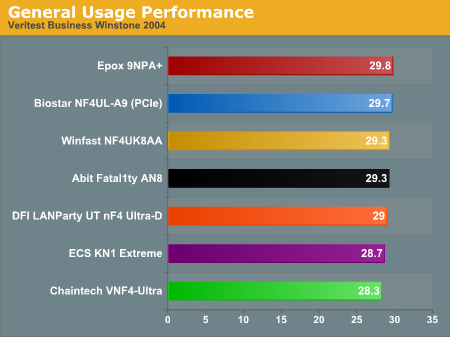
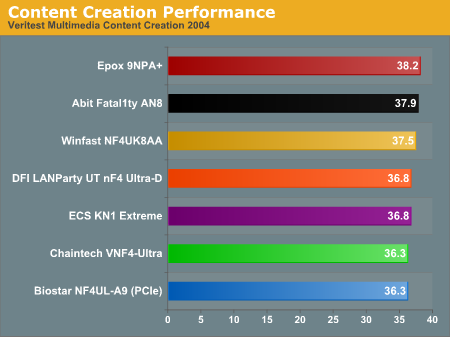
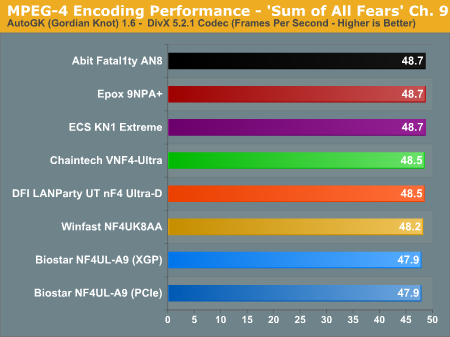
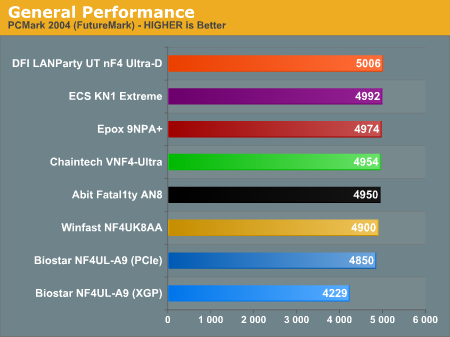
As we would expect, the Biostar performs the same in encoding whether running the PCIe or XGP graphics. This is confirmation that video has little impact on encoding results as we would expect. However, it is impossible to miss how very poorly the Biostar XGP performs in PCMark2004. Clearly, this is not a slot that is equal in performance to AGP 8X.
Gaming Performance
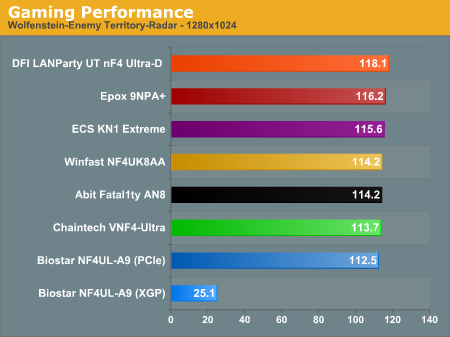
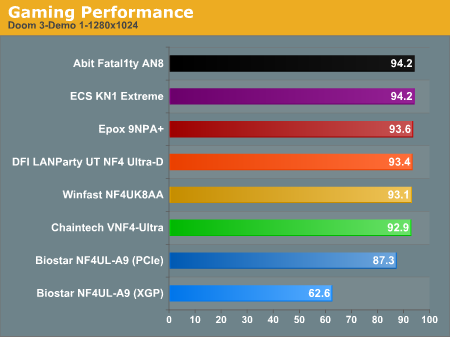
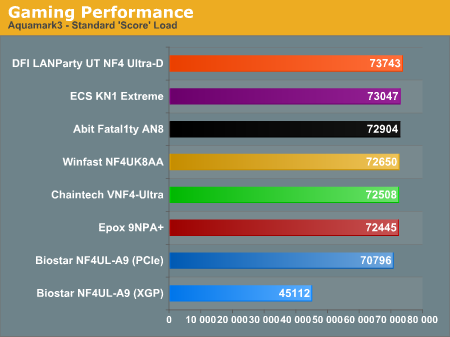
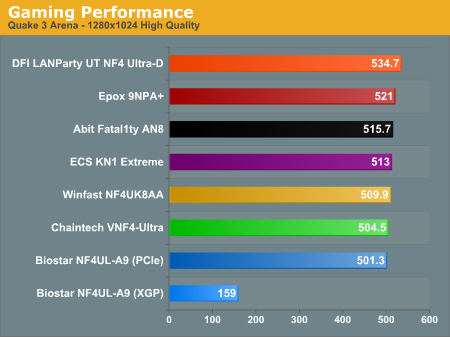
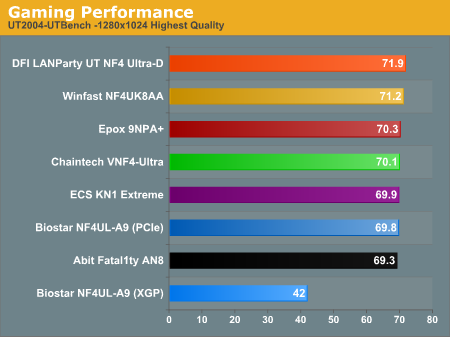
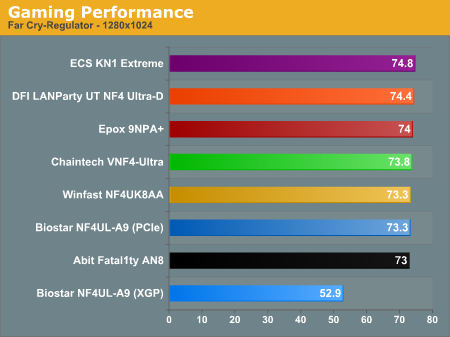
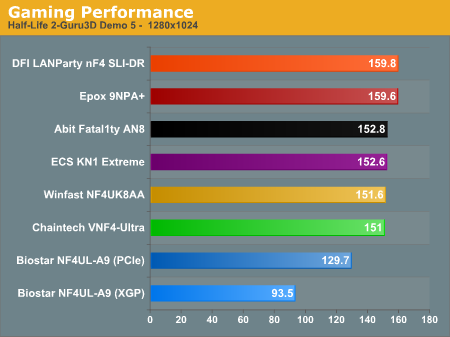
We have already established in past reviews that AGP and PCIe versions of the same video card running at the same speed perform the same. The only way the much slower performance of the Epox XGP slot can be explained is that the AGP 8X form factor slot is a convenience, and performance is definitely not up to AGP 8X levels. Those with AGP cards who want to bring them along in the PCIe transition will get service from the Biostar NF4UL-A9, but they will be disappointed severely if they are expecting AGP 8X level performance. However, the PCIe performance is up to the levels of PCIe on PCIe only motherboards, being just a bit slower than the competition.
3D Workstation Performance
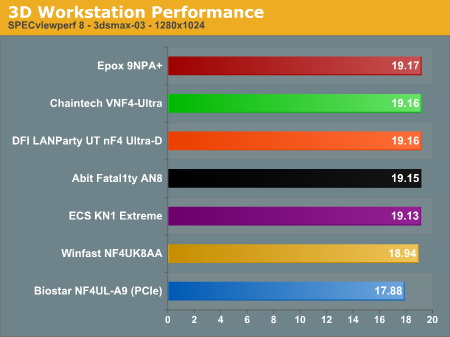
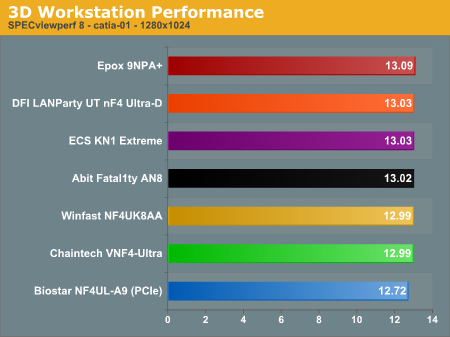

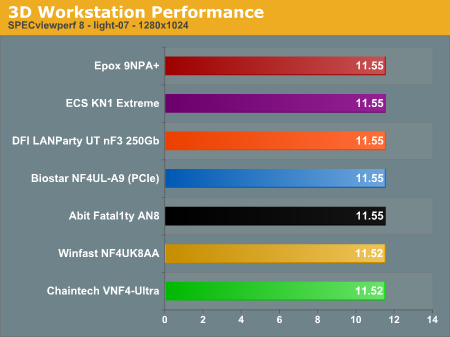
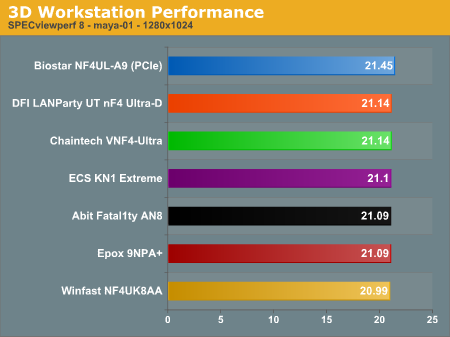
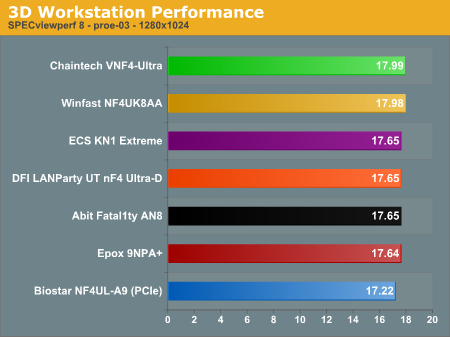
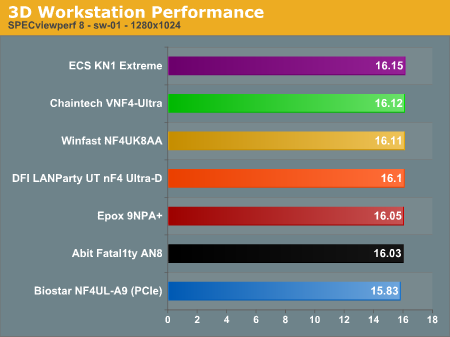
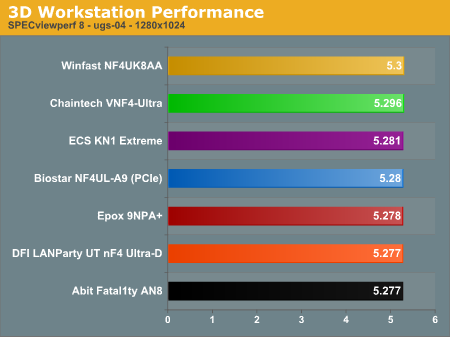
3D Workstation Performance shows a tight clustering of performance with different boards rising to the top depending on the benchmark. There is no clear winner among the nForce4 Ultra boards in SPECviewperf 8.01.
Overclocking
Maximum overclock data was added to Performance graphs beginning with the nForce4 SLI roundup several months ago. The overclocking performance graphs should allow better comparison of the overclocking capabilities of tested boards. For more details on the specific overclocking abilities of a specific board, please refer to the Overclocking and Memory Stress Test section of individual board reviews. Since the nForce4 Ultra and nForce4 SLI are based on the same chipset, performance should be directly comparable. You may want to look back at the results in nForce4 SLI Roundup: Painful and Rewarding to see a broader range of overclocking performance.
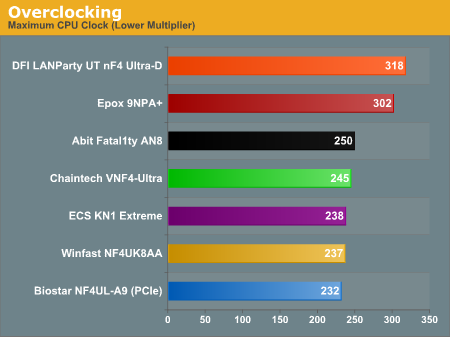
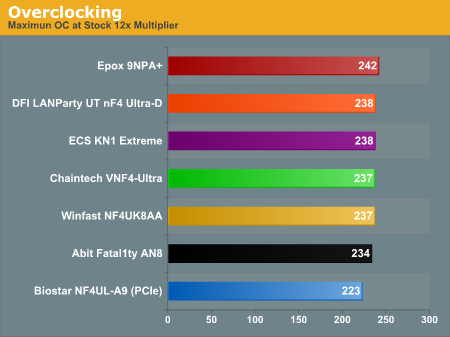
It is almost like some board makers understand how to overclock nForce4 motherboards and others are still struggling. Two boards clearly stand out in overclocking in this roundup:the Epox 9NPA+ and the DFI LANParty UT nF4 Ultra-D. These two turned in bus overclocks more than 50% higher than the third placed motherboard, and they were also the top two in stock ratio overclocking.
Disk Controller Performance
With so many storage controllers on the nForce4 SLI boards, we needed a means of comparing performance of the wide variety of controllers. The logical choice was Anand's storage benchmark first described in Q2 2004 Desktop Hard Drive Comparison: WD Raptor vs the World. To refresh your memory, the iPeak test was designed to measure "pure" hard disk performance, and in this case, we kept the hard drive as consistent as possible while varying the hard drive controller. The idea is to measure the performance of a hard drive controller with a consistent hard drive. We played back Anand's raw files that recorded I/O operations when running a real world benchmark - the entire Winstone 2004 suite. Intel's IPEAK utility was then used to play back the trace of all the IO operations that took place during a single run of Business Winstone 2004 and MCC Winstone 2004. To try to isolate performance difference to the controllers that we were testing, we used Seagate 7200.7 model SATA and IDE hard drives for all tests.iPeak gives a mean service time in milliseconds; in other words, the average time that each drive took to fulfill each IO operation. In order to make the data more understandable, we report the scores as an average number of IO operations per second so that higher scores translate into better performance. This number is meaningless as far as hard disk performance is concerned as it is just the number of IO operations completed in a second. However, the scores are useful for comparing "pure" performance of the storage controllers in this case.
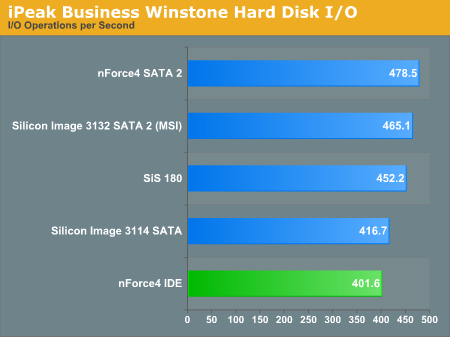
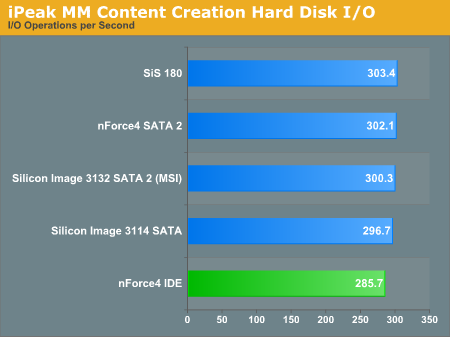
The Silicon Image 3114 controller is only a bit slower in MM Content IO, but it quite a bit slower in Business IO. The 3114 does uniquely feature RAID 3 capabilities.
IDE provided the slowest IO performance in this roundup, demonstrating that SATA controllers are finally starting to show a performance edge - at least in IO operations.
We also plan to include IDE RAID and SATA RAID benchmarks in future motherboard tests. Comparing RAID performance on various controllers will definitely be a part of future storage benchmarking and possibly motherboard tests as well as new on-board RAID controllers that are introduced.
Firewire and USB Performance
It is really difficult to put together a simple, repeatable, and consistent test to measure USB and Firewire Performance. Since our goal was to make this a standard part of motherboard testing, we needed a benchmark that was reasonably simple to run and that would also provide consistent results on the same test bed. We finally determined that an external USB 2.0, Firewire 400, and Firewire 800 hard disk might be a sensible way to look at USB and Firewire throughput.Our first efforts at testing with an IDE or SATA drive as the "server" yielded very inconsistent results, since Windows XP sets up cache schemes to improve performance. Finally, we decided to try a RAM disk as our "server", since memory removed almost all overhead from the serving end. We also managed to turn off disk caching on the USB and Firewire side by setting up the drives for "quick disconnect" and our results were then consistent over many test runs.
We used just 1GB of fast 2-2-2 system memory set up as a 450MB RAM disk and 550MB of system memory. Our stock file was the SPECviewPerf install file, which is 432,533,504 bytes. After copying this file to our RAM disk, we calculated the time for writing from the RAM disk to our external USB 2.0 or Firewire 400 or Firewire 800 drive using a Windows timing program written for AnandTech by our own Jason Clark. The copy times in seconds were then converted into Megabits per second (Mb) to provide a convenient means of comparing throughput. Higher Rates therefore mean better performance.
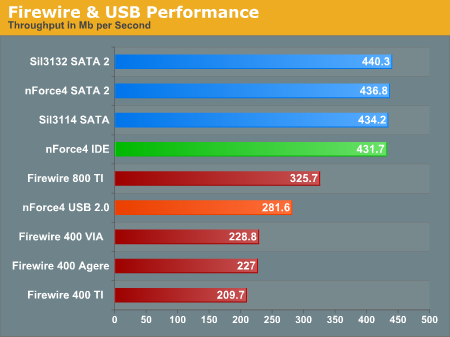
Our test is just one of many throughput tests, but in this benchmark, it is clear that the VIA Firewire 400 and Agere 400 are faster than TI's 1394a chip.
All of the SATA solutions also slightly outperform IDE in our timed copy from RAM disk. We did not have 3Gb/s drives to test with the onboard NVIDIA SATA 2, but it is still interesting that throughput with a SATA 1 drive is still a bit faster on the SATA 2 controllers than on SATA 1. For more information on SATA 2 3Gb/s performance, please check a recent review under the Storage tab at the top of the page.
Ethernet Performance
We have often talked about the throughput advantage of PCI Express compared to PCI and its impact on Gigabit LAN performance. To show you this, the new motherboard test suite includes LAN performance measurements.The Windows 2000 Driver Development Kit (DDK) includes a useful LAN testing utility called NTttcp. We used the NTttcp tool to test Ethernet throughput and the CPU utilization of the various Ethernet Controllers used on the nForce4 Ultra motherboards.
We set up one machine as the server; in this case, an Intel box with an Intel CSA Gigabit LAN connection. Intel CSA has a reputation for providing fast throughput and this seemed a reasonable choice to serve our Gigabit LAN clients. At the server side, we used the following Command Line as suggested by the VIA whitepaper on LAN testing:
Nttcps - m 4,0,On the client side (the motherboard under test), we used the following Command Line:-a 4 - l 256000 - n 30000
Nttcpr - m 4,0,At the conclusion of the test, we captured the throughput and CPU utilization figures from the client screen.-a 4 - l 256000 - n 30000
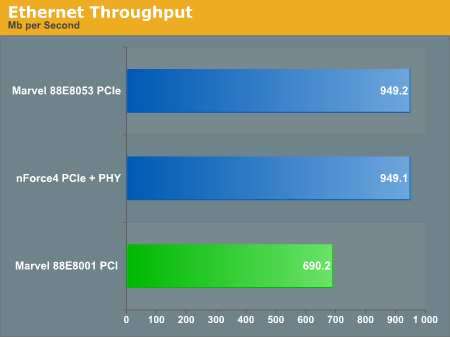
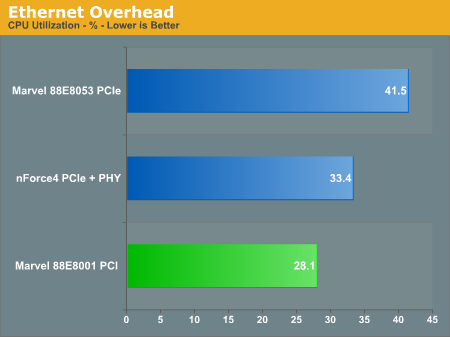
All Ethernet tests were performed with standard frames, but Gigabit Ethernet supports Jumbo frames as well. Jumbo frames will theoretically provide a further reduction in CPU overhead. We have seen test results that show the combination of Active Armor and Jumbo Frames can reduce CPU utilization below 10%, which is very respectable performance for on-chip gigabit LAN.
Audio Performance
For this Ultra roundup, we limited audio testing to the Rightmark 3D Sound CPU utilization test, which is the same benchmarks that were run in the nForce4 SLI roundup. This benchmark measures the overhead or CPU utilization required by a codec or hardware audio chip.
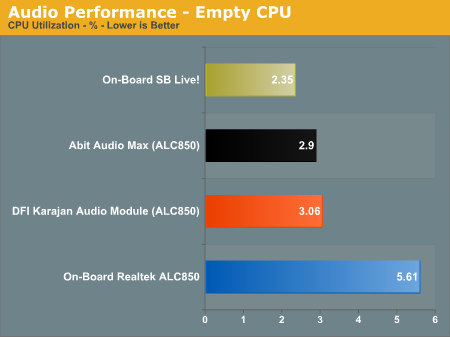
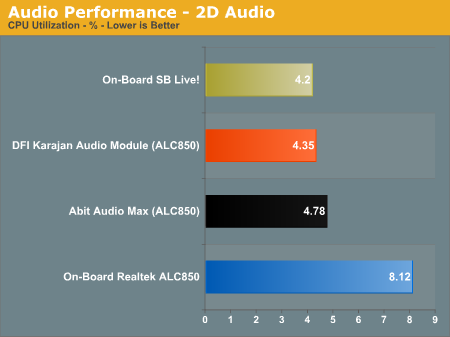
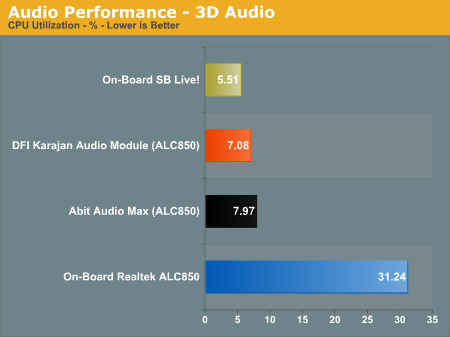
DFI and Abit deserve praise for their excellent design work on the Karajan module and the Audio Max respectively. They both reduce overhead substantially to very low levels compared to competing implementations of the same Realtek ALC850 codec.
Final Words
Our nForce4 journey began at the retail level several months ago with nForce4 SLI Roundup: Painful and Rewarding. In that early look at nForce4 SLI motherboards, we found a much larger variation in performance, overclocking, features, and feature performance than what we really expected. It was early in nForce4, so we could chalk up these big differences to an immature chipset. Now, we fast forward a few months to this nForce4 Ultra roundup, and we once again have found a huge variation in the overall performance of motherboards in this roundup. It's not so simple a few months later to chalk up these differences to a learning curve. We are much more inclined this go-around to say that it seems that some board makers understand nForce4 and AMD and do a good job with it, while other board makers really don't get it.The AMD enthusiast has always been a unique beast as he will readily admit that he/she relishes the idea of getting something for nothing. That is why AMD buyers will never tolerate a motherboard that thwarts their efforts to squeeze even more performance from their Athlon 64 chips. There are many Intel users who would never think of overclocking their chips or manipulating multipliers for greater performance. But there are very few AMD users who haven't at least considered a whole host of options to gain more performance from their processors. Perhaps that is why all AMD Athlon 64 chips are unlocked downwards and only a few, very expensive, select Intel chips feature this same capability. It is also perhaps why the top Athlon 64 chips, the FX chips, are completely unlocked.
This is not an argument for or against either approach. It is merely to point out that AMD users are quite often a different breed of end-users with a different set of expectations of their computer motherboards. Manufacturers who understand this sell lots of AMD Athlon 64 motherboards, while those that don't get relegated to the bargain bins.
As AnandTech has been pointing out since Computex, things are changing in Desktop sales. AMD is now reported to be at 60% or more of retail motherboard sales. As a result, people who only toyed with AMD before now want a piece of this action. To them, we will say it takes more than calling a board an AMD enthusiast board to make it so. So ECS, Foxconn, Biostar - we can only suggest that you need to add features and performance that will make an AMD user want to buy your boards.
Chaintech is a puzzle here, since they have traditionally built excellent AMD boards at a very reasonable price. The VNF4-Ultra is not a bad board, and it does perform reasonably, but it is way below the standards set by the two leaders in this roundup. Perhaps an even bigger surprise is the dismal performance of the very expensive Abit AN8 Fatal1ty. Abit understands this market, but they apparently are having a bit of a learning curve in their move from their recent VIA chipset A64 motherboards to NVIDIA chipsets for A64. Or, perhaps there are other reasons. Whatever the reason, the priciest board in this roundup from an overclocking name like Abit should not be stuck at 50% of the bus overclock that is achieved by the DFI and Epox boards. What makes the Abit even more puzzling is the really excellent asynchronous overclocking results that we could achieve with this same board - but then again, we don't report and compare asynchronous OC; we run and compare 1:1. Perhaps it is as simple as a BIOS update, though there have already been several for this board.
So, out of seven boards in this roundup, two clearly rise to the top. The Epox 9NPA+ Ultra at $110 is an amazing performer with virtually everything that an Athlon 64 enthusiast could want - except official support and voltages for OCZ VX and Mushkin Redline memory. It will, however, handle every other memory with abandon. If you want all that the Epox offers, a little better bus overclocking and official support and voltages for OCZ VX and Mushkin Redline at a little higher price, then the DFI LANParty nF4 Ultra-D is your choice.
You should also consider the MSI K8N Neo4 Platinum a winner here as well. The SLI version of the MSI was a Gold Editor's Choice in our SLI roundup, and the Ultra version should perform at the same excellent levels we saw with the MSI SLI. The MSI has had issues in the recent past with overclocking the latest Venice and San Diego processors, but MSI has recently released a BIOS that is reported to bring Venice/San Diego performance in line with the excellent performnace we saw with a 4000+ clawhammer on the MSI SLI.
Based on stock performance, overclocking abilities, features, and the performance of features present on the boards, we are pleased to award our Editors Choice Gold Award for best nForce4 Ultra motherboard jointly to the Epox 9NPA+ Ultra and the DFI LANParty UT nF4 Ultra-D. Both boards are clearly standouts in a group of very uneven performance.
 |
The Epox 9NPA+ Ultra is the fastest board in the roundup at stock speeds. It was also the highest overclocker at stock speeds, and the second highest overclocker when the bus was overclocked. The Epox is an incredible value whether you are looking for a board that will run fast with stability at stock speeds or a board that will satisfy almost any Athlon 64 enthusiast. The range of overclocking options and the overclocked performance are among the best that we have seen, falling short only in the memory voltage area, which tops out at 3.1V. The feature set is more or less average for Ultra boards, but the overall performance is clearly standout. Based on the standout performance and solid overclocking that we achieved with the Athlon 64, we are pleased to award the AnandTech Gold Editors Choice to the Epox 9NPA+ Ultra motherboard. |
If you looking to save even more money, the 9NPA, based on the nForce4 x4 chipset, has a street price of around $90. You give up the SATA 2 support and 1000 bus, but most of the performance features are still available in the same basic motherboard.
The Gold Editors Choice is jointly awarded to the DFI LANParty UT nF4 Ultra-D.
 |
The DFI nForce4 boards were designed first and foremost for the Athlon 64 Enthusiast. The DFI nF4 Ultra is the exact same board, same BIOS, and same performance as the DFI SLI motherboard. The only difference is the Ultra and SLI versions of the same chipset. The DFI exhibits above average performance at stock speeds, but it is the best overclocker of bus speeds that we have ever tested - reaching 318x9 with a 4000+ CPU. It was also just behind the Epox in overclocking at stock speeds. The DFI nF4 boards remain to be the only motherboards to fully support high voltage high-speed 2-2-2 memory with memory voltages to 4.0V for OCZ VX and Mushkin Redline memory. The DFI LANParty UT nF4 Ultra-D is the ultimate enthusiast board at a value price with overclocking performance that will never require an apology. DFI's nForce4 boards have quickly become a legend among enthusiasts. |
We extend our congratulations to both DFI and Epox who deserve recognition for the hard choices that they made in bringing these two products to market. Both companies clearly understand what it takes to capture the imagination of AMD buyers. It isn't just saying a board is aimed at the enthusiast that sells an Athlon 64 board, it is in delivering the options and performance that are part and parcel of the AMD Enthusiast label.

